White patterns
- White patterns cause a lack of color pigment in the coat, resulting in pink skin and white hairs.
- Always goes "over" the base coat, any dilutions, modifiers, and pattern genes.
- Can generally cause blue eyes if the white markings reach the eyes, unless otherwise specified.
- Hooves and horns will be lighter when affected by white.
Effects
- Skin: skin will be light pink under any white patterns
- Horns and hooves: hooves will be light where white leg markings connect [Horn & hoof color guide]
- Eye color: natural white generally doesn't affect eye color, because the markings shouldn't touch the eyes. [Eye color guide]
Appearance
Natural white markings are allowed on any horse, regardless of their genotype.
Natural white markings are limited to the face and legs, where the minimal allowed is completely hidden, and the maximal allowed is a wide blaze (not extending past the eyes) and white socks reaching the knees
The markings can be mixed and matched freely, e.g. a large white blaze with no white legs, or white socks of different shapes with no face markings present.
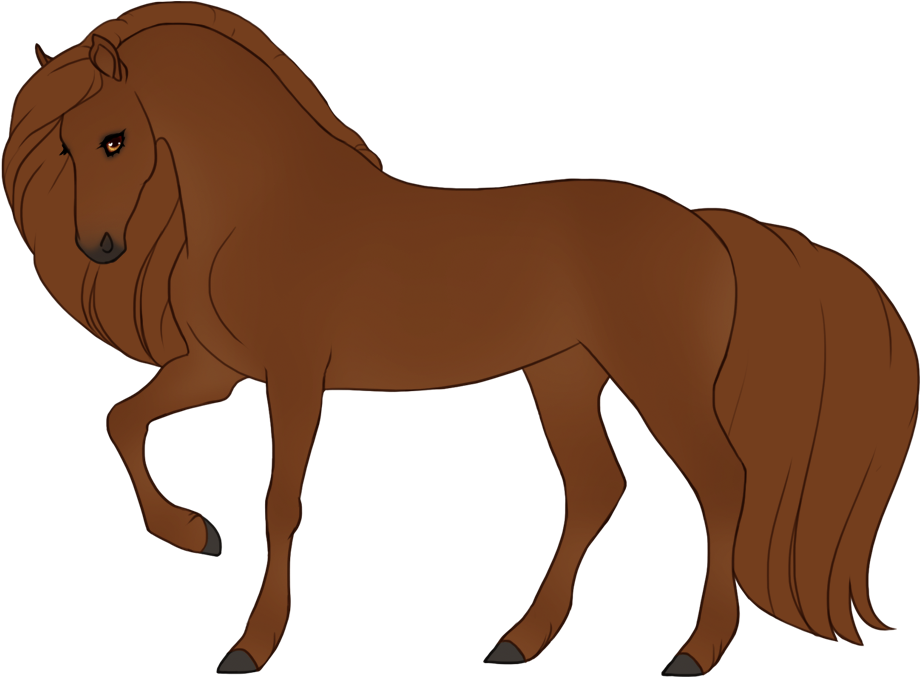
Minimal natural white (no white) on chestnut
chestnut
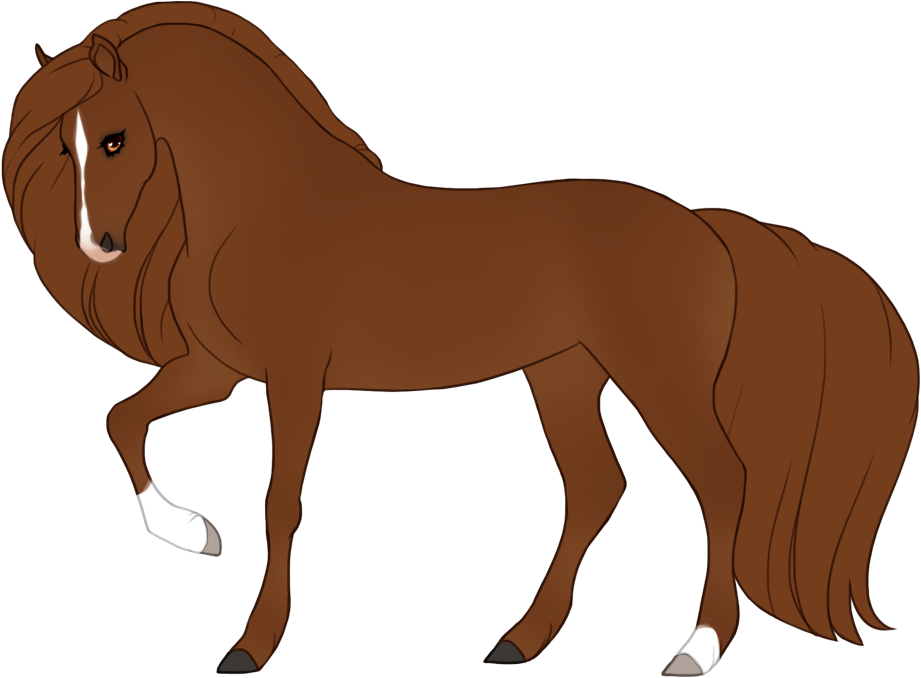
Natural white on chestnut
chestnut
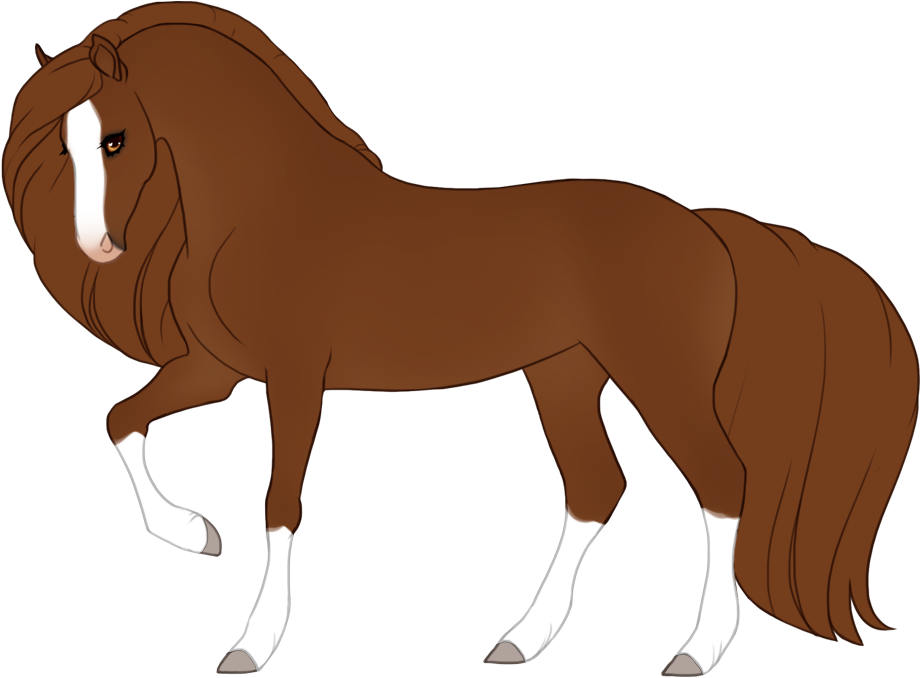
Maximal natural white on chestnut
chestnut + tobiano
Tobiano
ToTo / nTo
Effects
- Skin: skin will be light pink under any white patterns
- Horns and hooves: hooves will be light where white leg markings connect [Horn & hoof color guide]
- Eye color: tobiano generally doesn't affect eye color, because tobiano markings shouldn't touch the eyes. [Eye color guide]
Appearance
Tobiano is characterized by tall white socks connecting to the topline of the horse.
The coloured areas are usually round-shaped and appear as larger and smaller holes in the white pattern, starting from the head, chest and flanks but can also appear anywhere else on the body.
Facial markings should always be minimal, generally not exceeding the maximal area of Natural white.
It is not uncommon for tobianos to have a "split tail" appearance where half the tail is white and half the tail is colored (it can be split either way - white top and colored bottom, or colored top and white bottom).
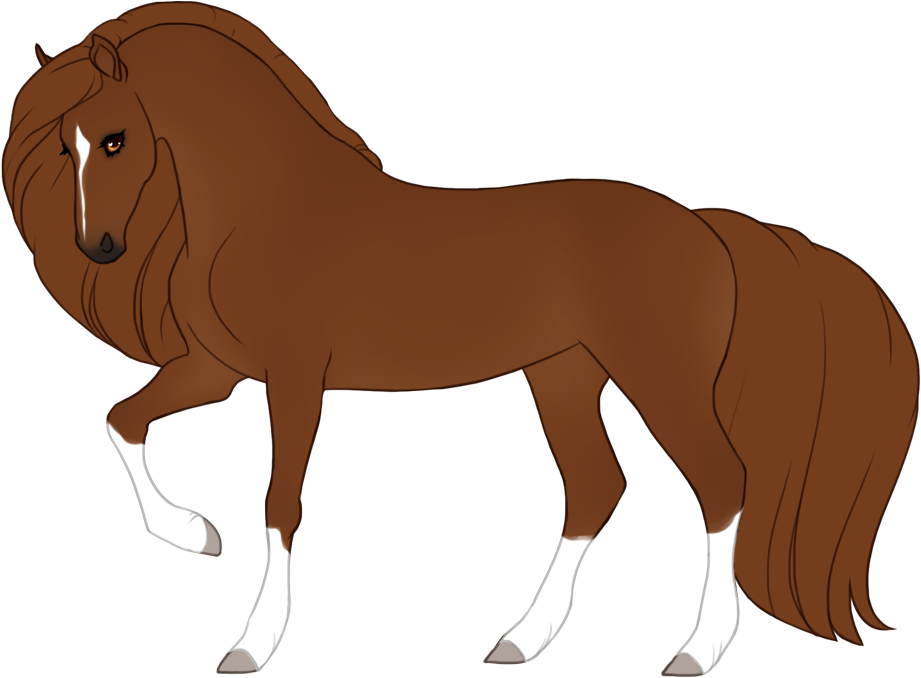
Minimal tobiano
chestnut + tobiano
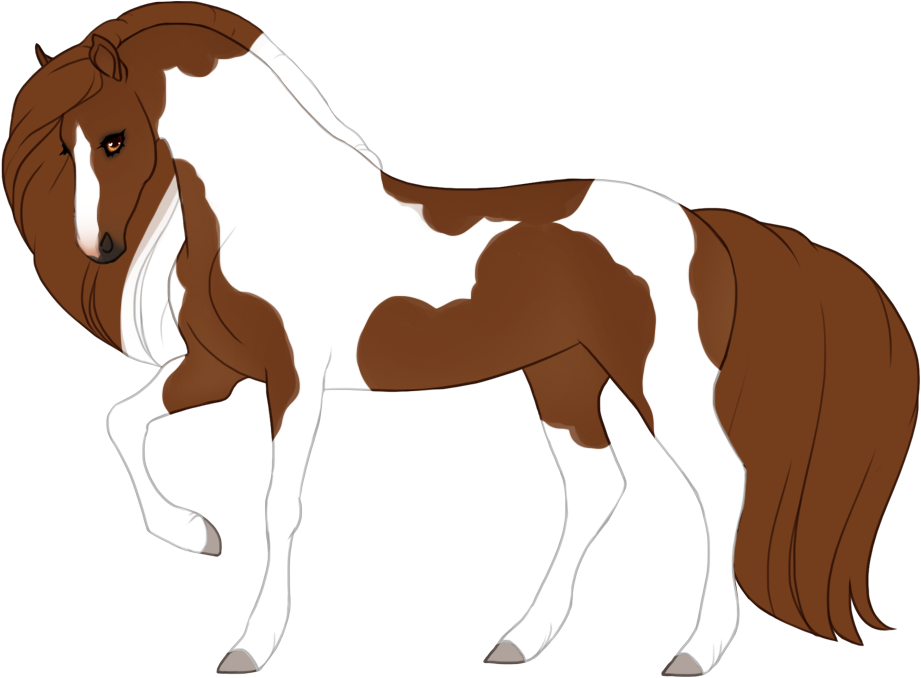
Tobiano
chestnut + tobiano
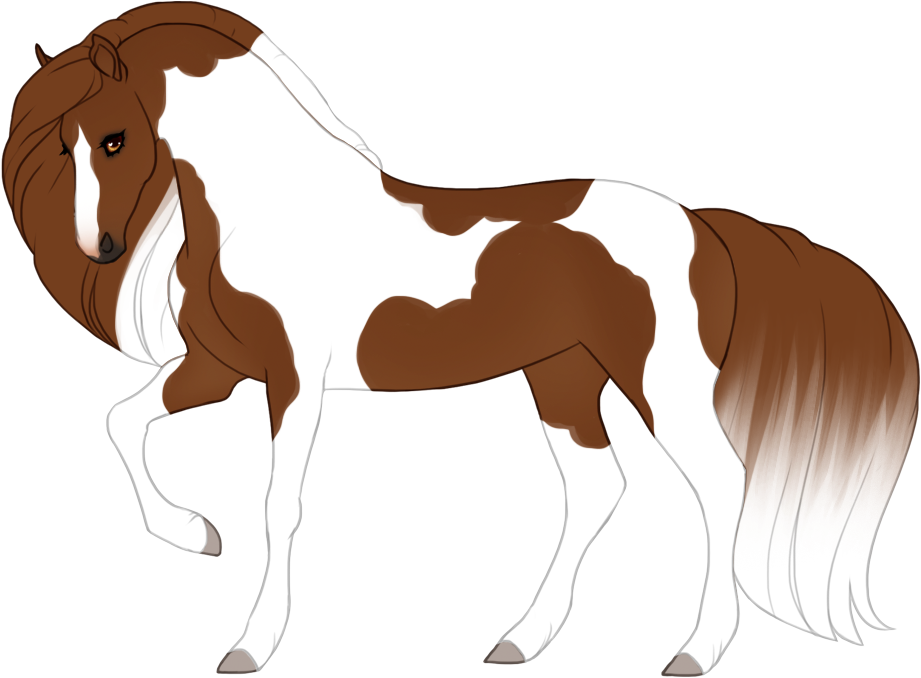
Tobiano with split tail
chestnut + tobiano
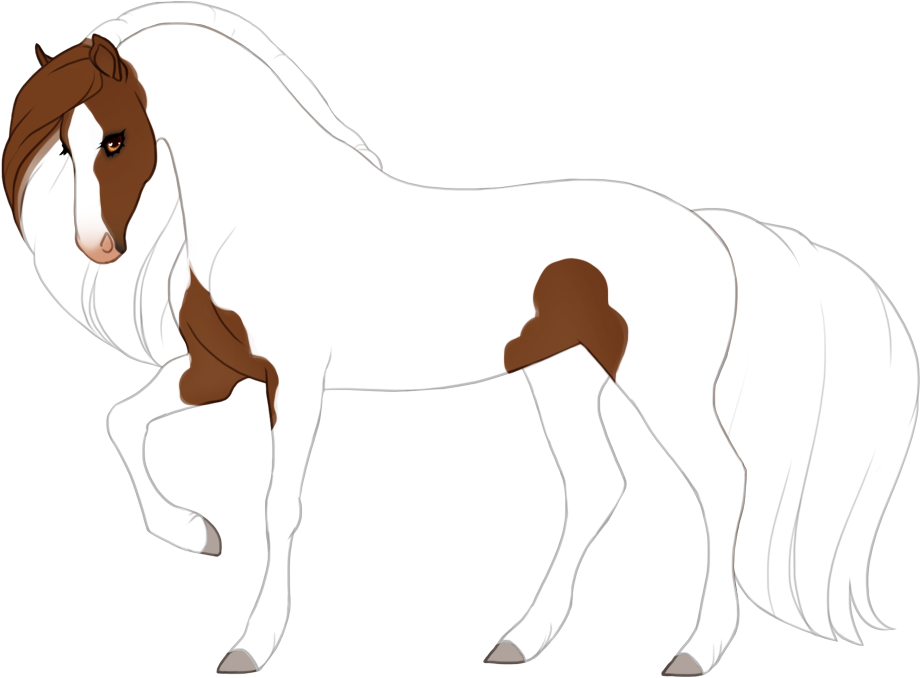
Maximal tobiano
chestnut + tobiano
Optional effect: Cat tracks
Cat tracks causes small spots or "holes" in the white markings, and can have a roaned or clumped-together appearance.
These small spots will affect mane/tail and hooves as shown in the examples.
Cat tracks are not written in the phenotype, a tobiano horse with cat tracks would still only be described as tobiano.
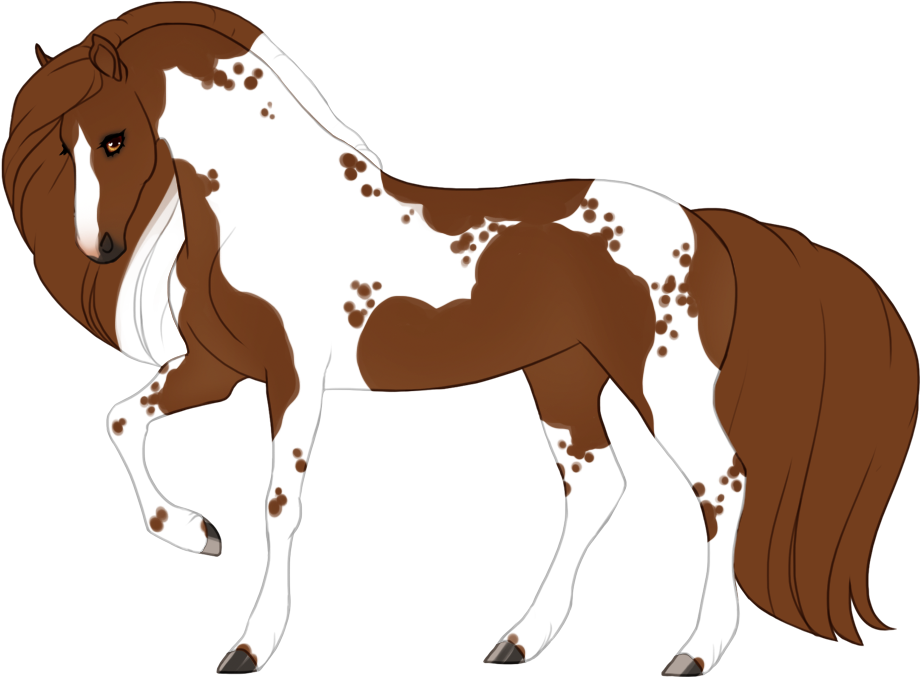
Tobiano with cat tracks
chestnut + tobiano
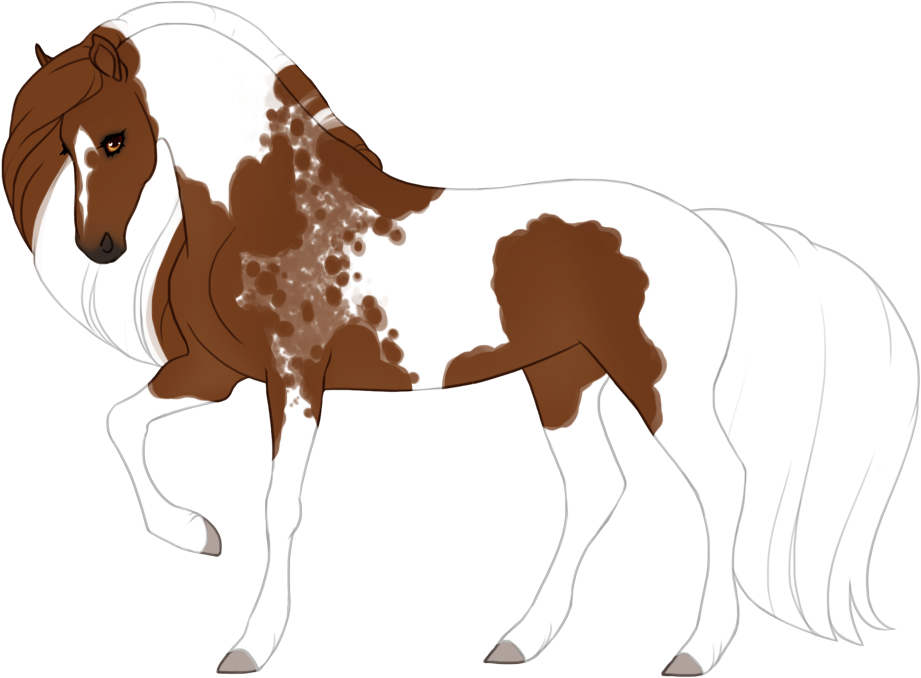
Tobiano with clumped cat tracks
chestnut + tobiano
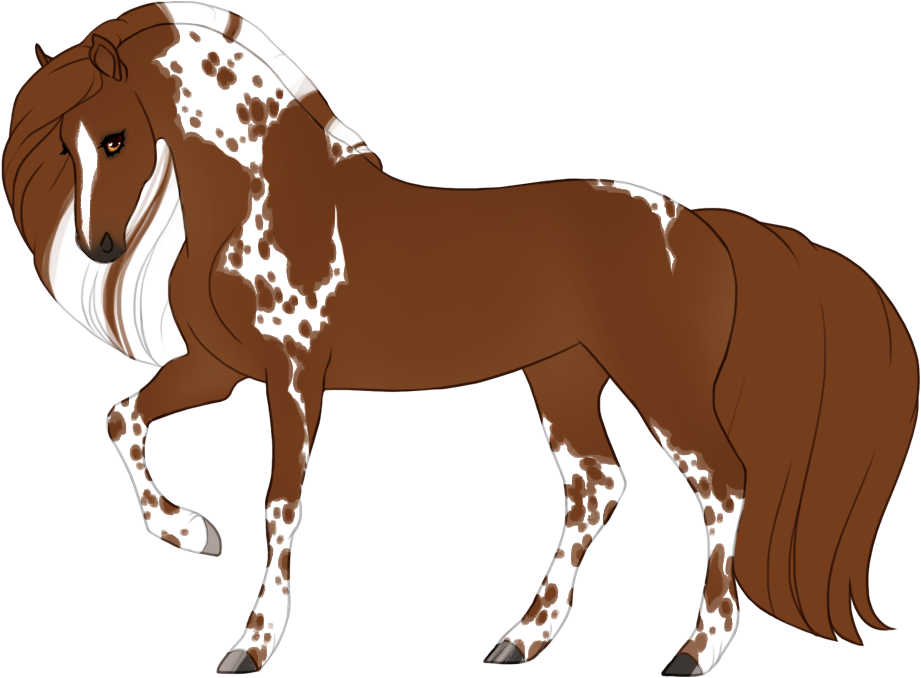
Tobiano with extensive cat tracks
chestnut + tobiano
Optional effect: Calico
Calico tobiano causes large patches of darker and/or lighter color similar to the base coat.
The patches should have an apperance similar in shape to regular tobiano markings, and can also display cat tracks.
These calico patches can optionally affect mane and tail where it touches, but it is not required. White markings should still affect mane and tail where it touches.
Calico is not written in the phenotype, a calico tobiano horse is still only called tobiano.
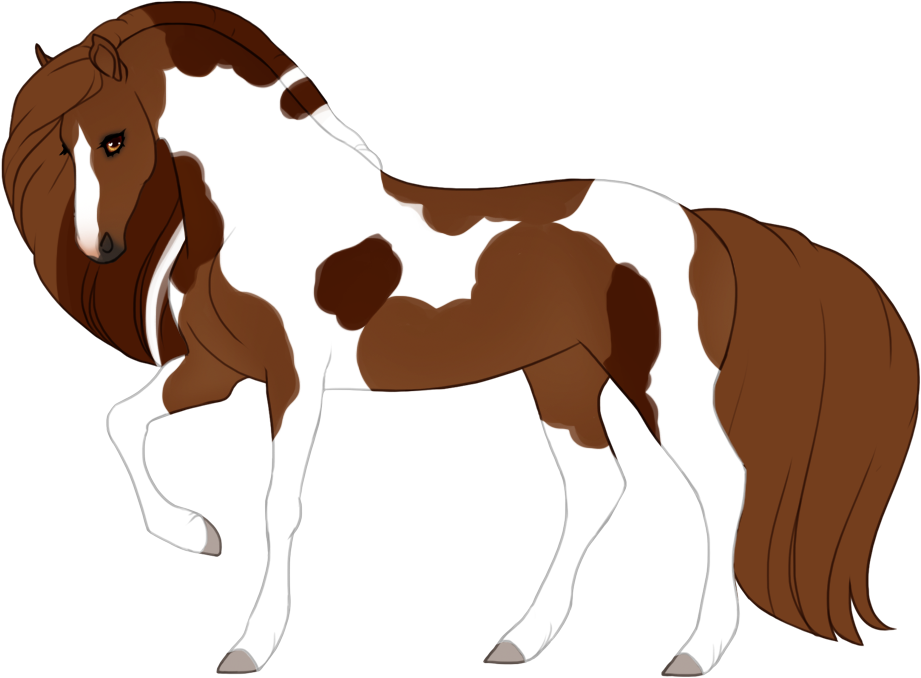
Calico tobiano with darker patches
chestnut + tobiano
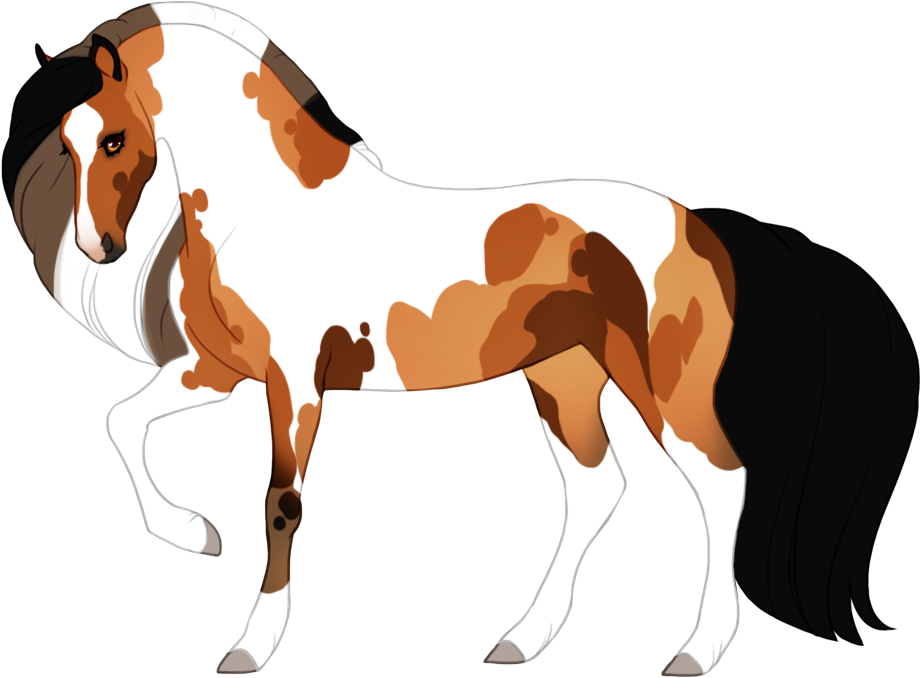
Calico tobiano with both lighter and darker patches
bay + tobiano
Sabino
SbSb / nSb
Effects
- Skin: skin will be light pink under any white patterns
- Horns and hooves: hooves will be light where white leg markings connect [Horn & hoof color guide]
- Eye color: eyes can optionally be blue if the white face markings reach the eyes [Eye color guide]
Appearance
Sabino is characterized by white markings with very uneven/irregular or even roaned edges, starting from the legs and often causing white spotting on the belly, as well as bold white face markings.
Sabino horses often have white speckling throughout their coat, and subtle roaning.
Even as a maximally expressed sabino there should still be some coloured areas or speckling visible.
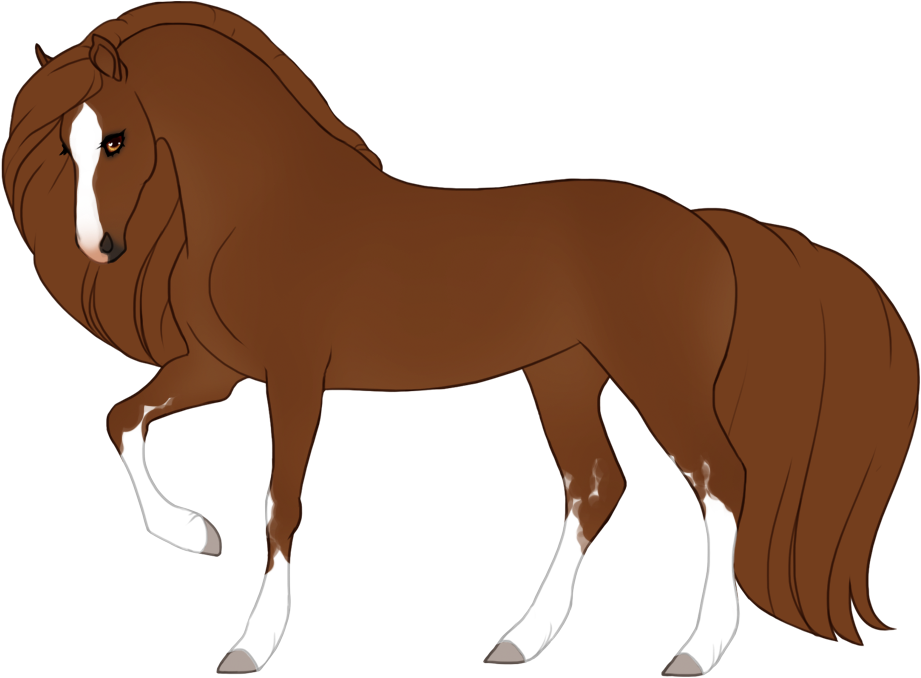
Minimal sabino
chestnut + sabino
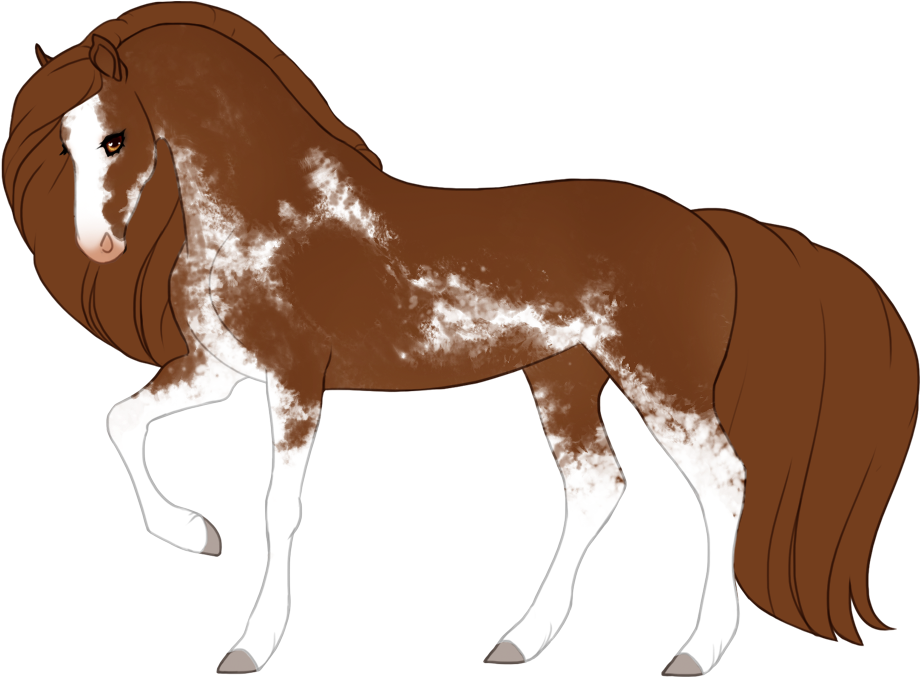
Sabino
chestnut + sabino
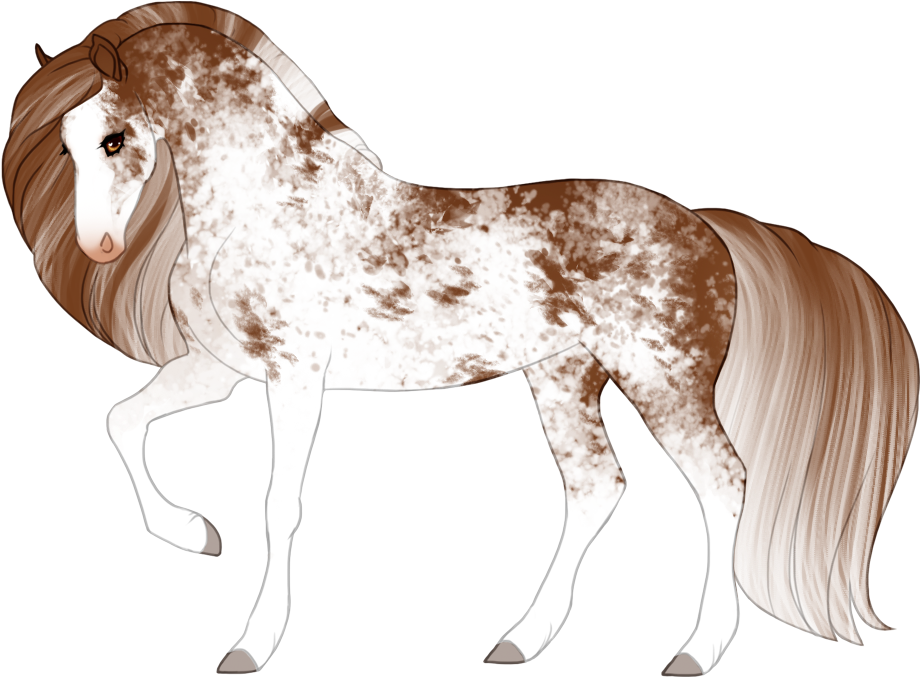
Maximal sabino
chestnut + sabino
Optional effect: Silvertail
Even if sabino markings are minimal or barely visible at all, the tail can be fully or partially white.
A partial expression appears as a soft gradient where the bottom of the tail is white or much lighter than the base of the tail. A full expression makes the tail completely white.
Silvertail is not written in the phenotype, a silvertailed sabino horse is still only called sabino.
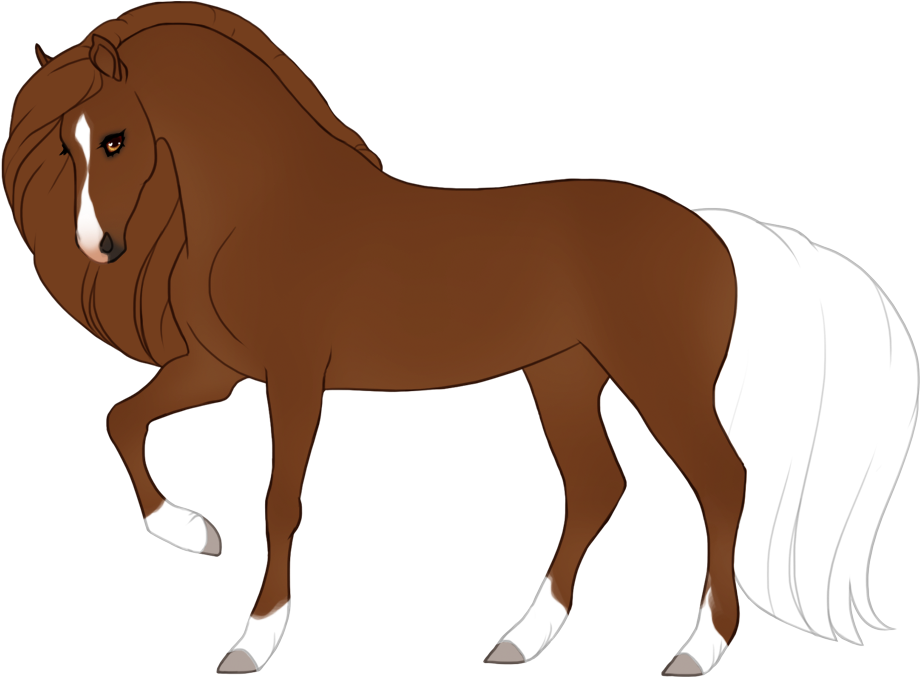
Solid white silvertail
chestnut + sabino
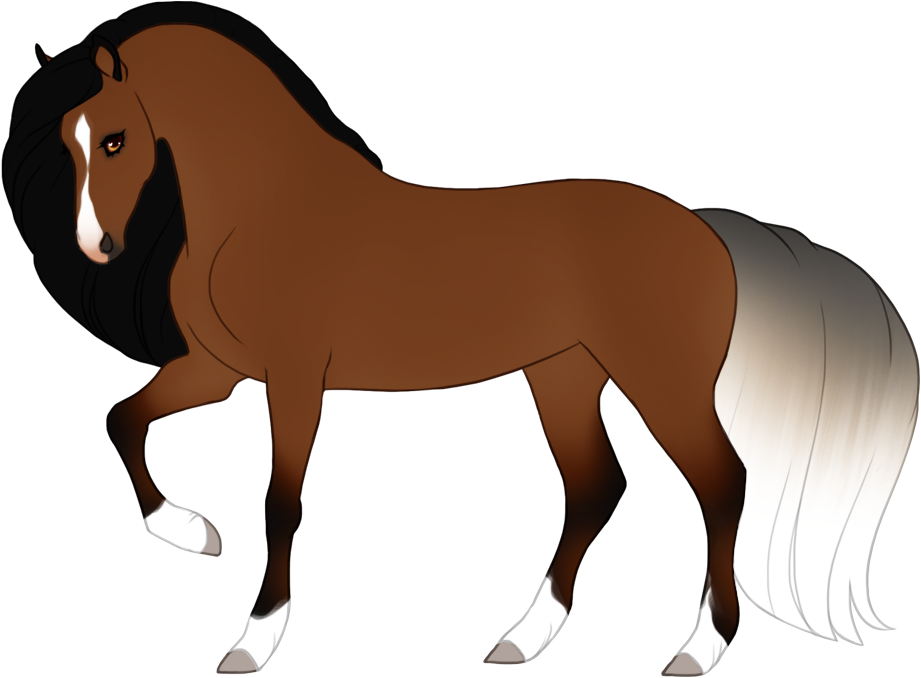
Partial silvertail
bay + sabino
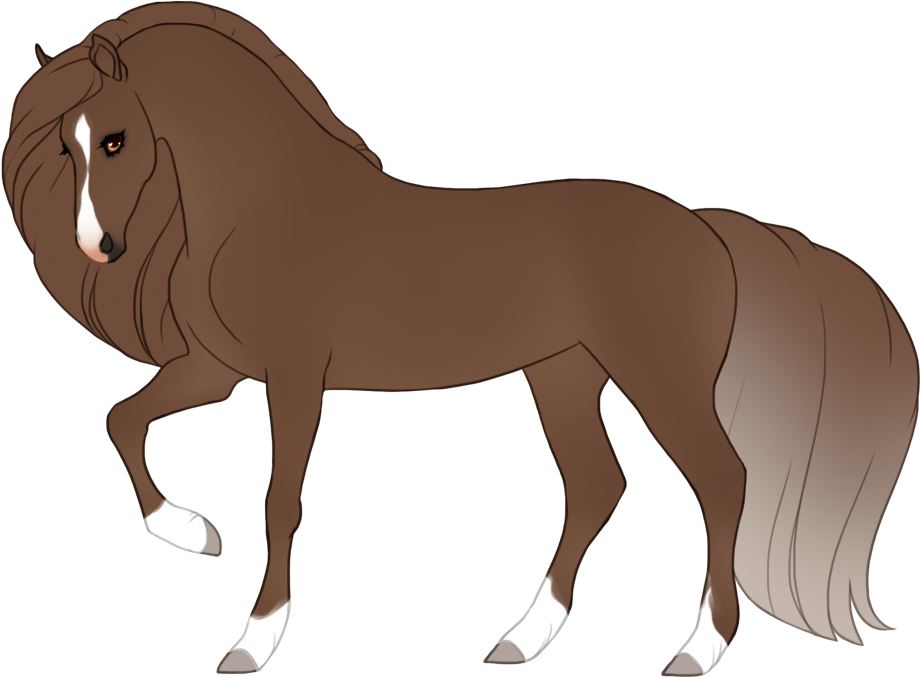
Subtle partial silvertail
chestnut + sabino
Optional effect: Badger face
Both sabino and overo can have the badger face marking, causing the white facial marking to have occluded spots, appearing as reversed blazes or white stripes along the sides of the head.
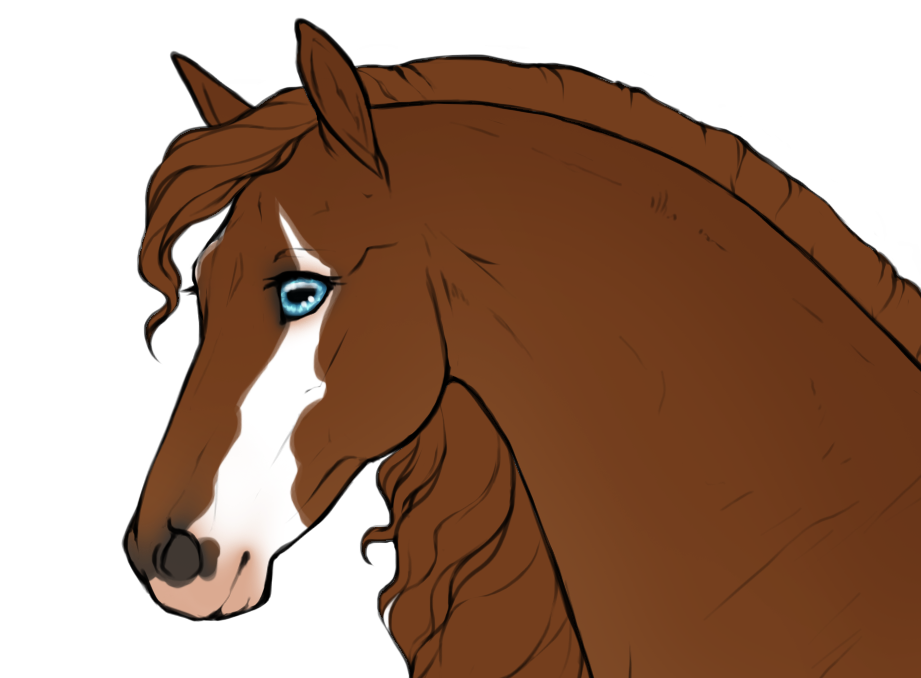
Broken badger face
chestnut + sabino
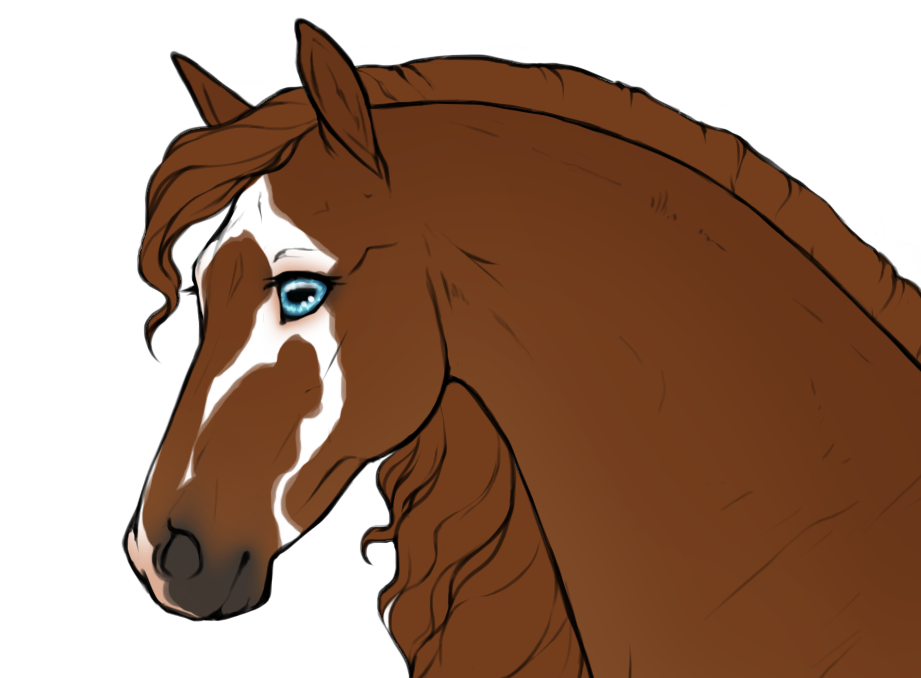
Asymmetrical badger face
bay + sabino
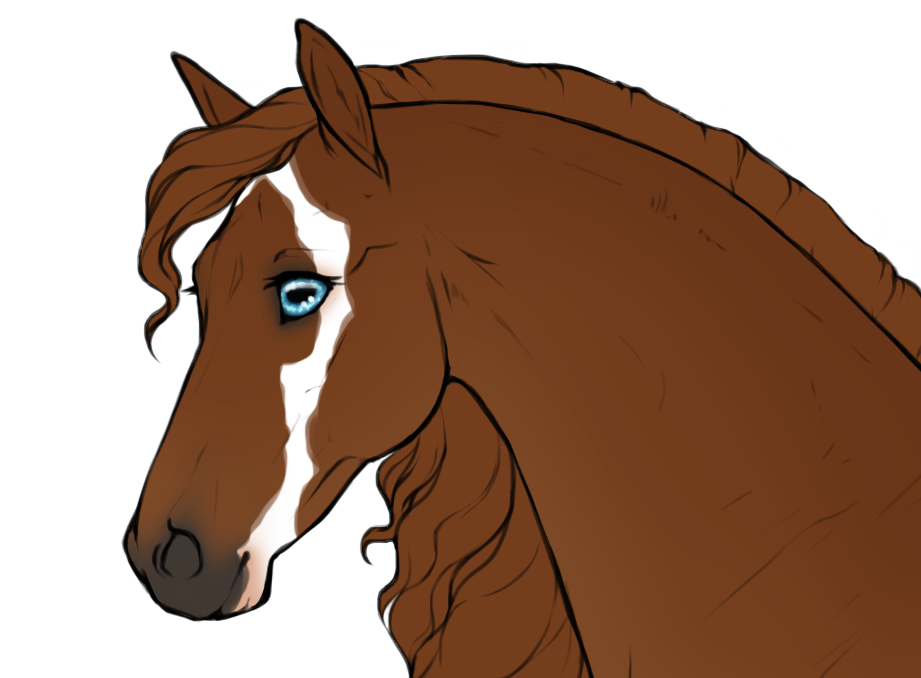
Thin lined badger face
chestnut + sabino
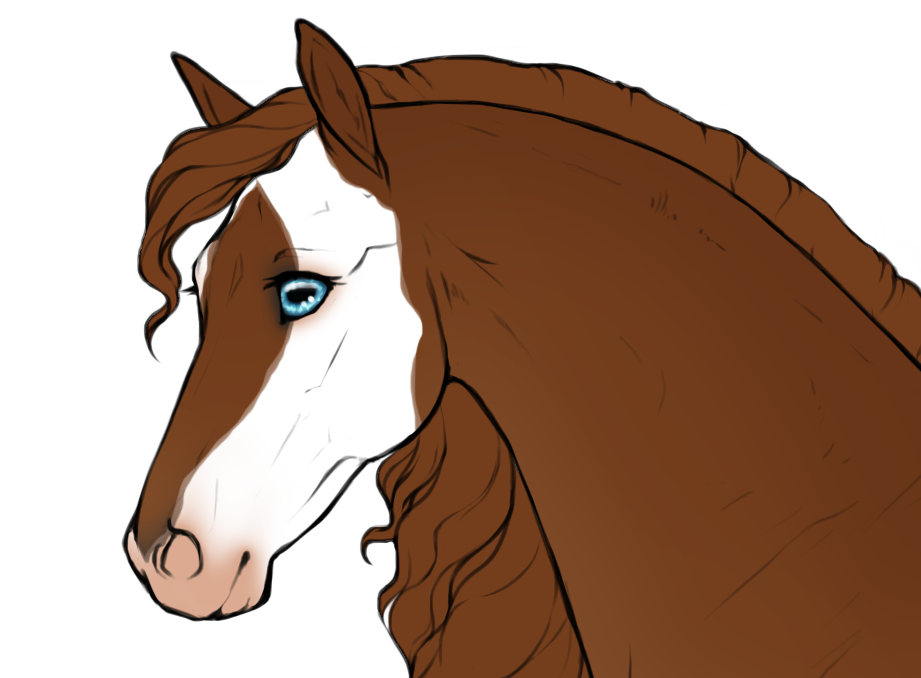
Thick lined badger face
chestnut + sabino
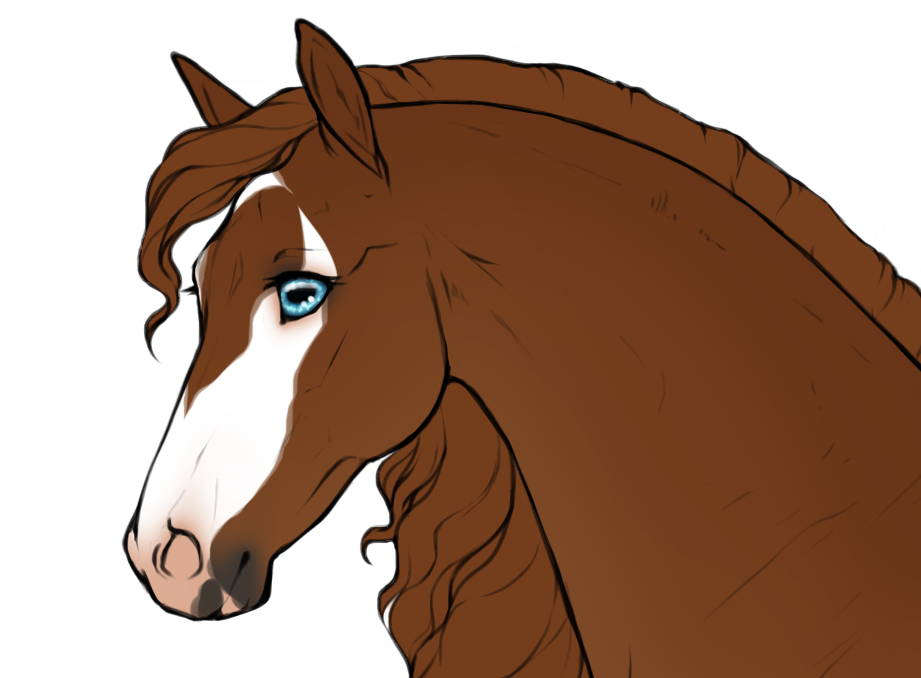
Half badger face
bay + sabino
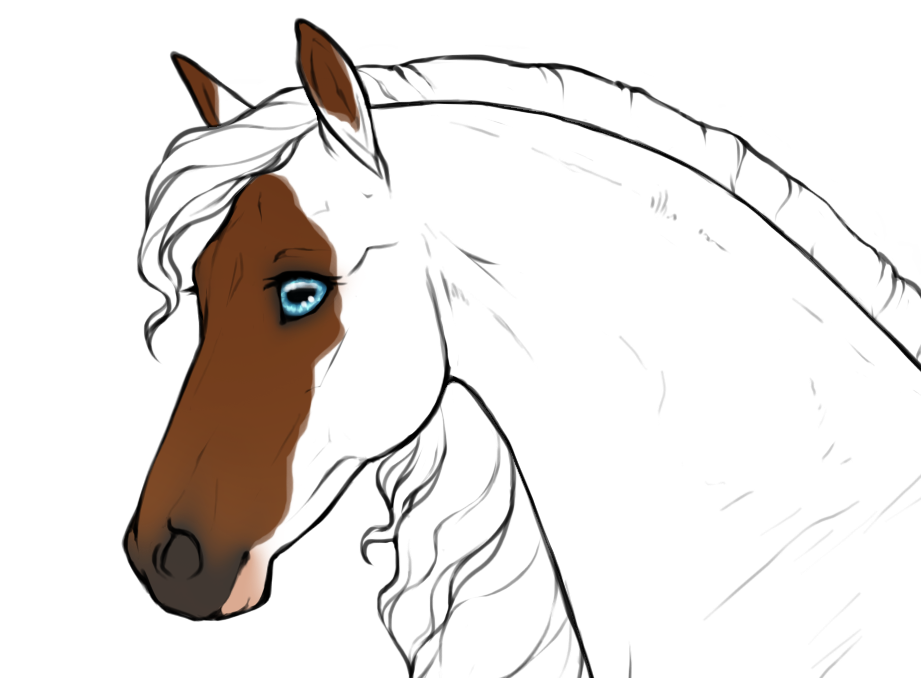
Occluded blaze badger face
chestnut + sabino
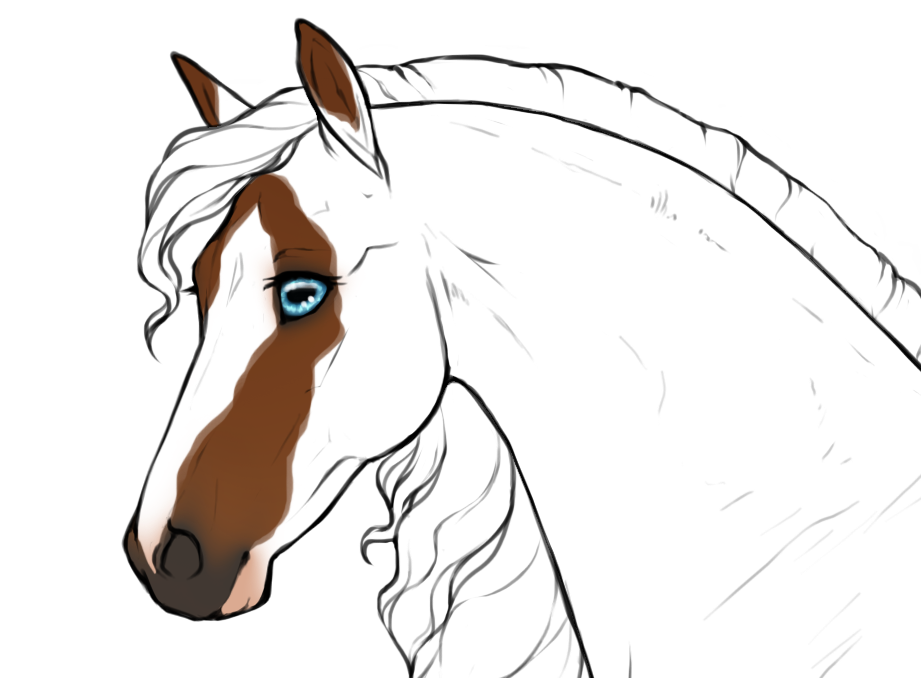
Reversed badger face
chestnut + sabino
Splash
SplSpl / nSpl
Effects
- Skin: skin will be light pink under any white patterns
- Horns and hooves: hooves will be light where white leg markings connect [Horn & hoof color guide]
- Eye color: eyes can optionally be blue even if white facial markings do not reach them, and will always be blue if white markings do reach. [Eye color guide]
Appearance
Splash causes white markings appearing as if the horse has been dipped in white paint. The markings should always start from the hooves and bottom of the face, and extend upwards
The edges of the markings should be smooth/even, and not have roaning or holes. The only exception is the face, where the eyes and lips can have spots showing the base coat color.
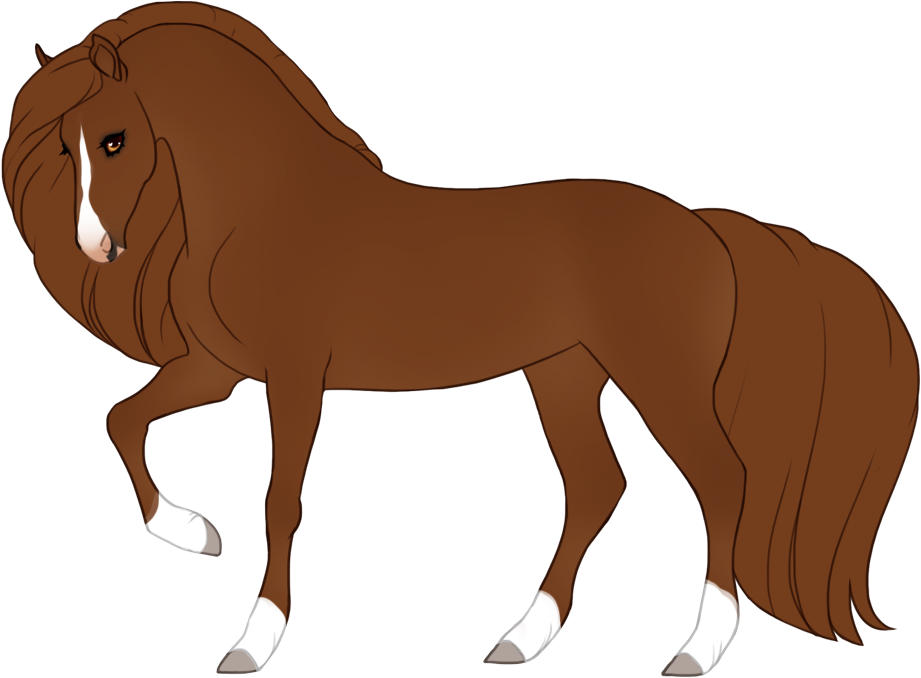
Minimal splash
chestnut + splash
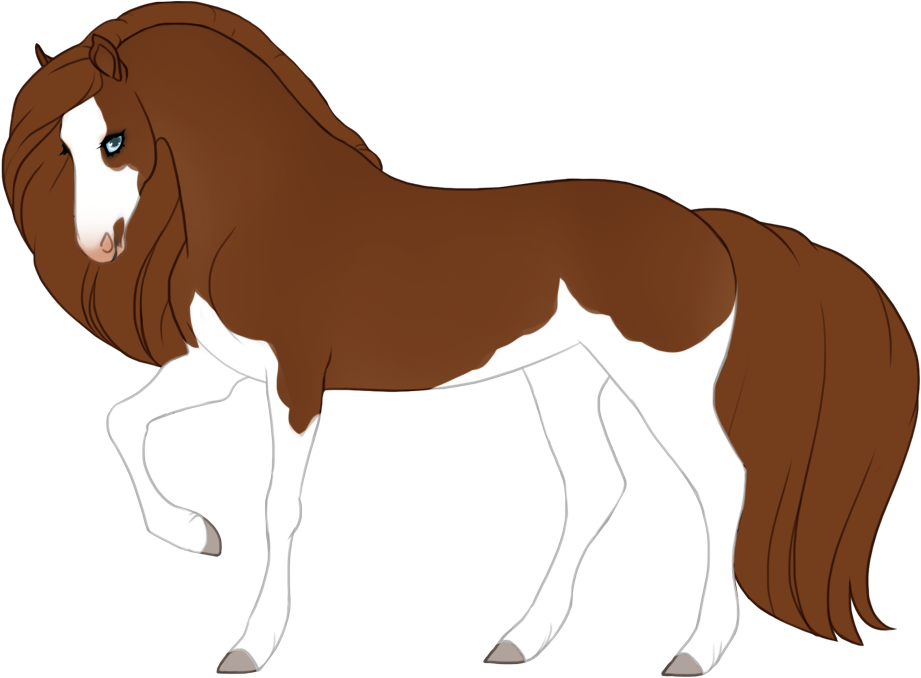
Splash
chestnut + splash
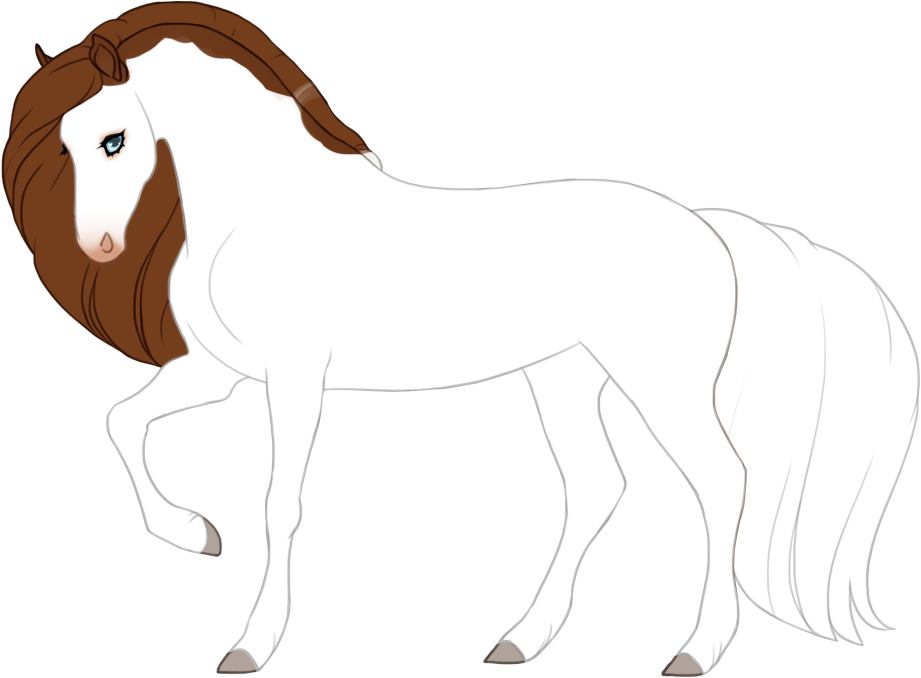
Maximal splash
chestnut + splash
Blaise
BlsBls / nBls
Effects
- Skin: skin will be light pink under any white patterns
- Horns and hooves: blaise generally doesn't affect hoof color, because blaise markings shouldn't extend past the knees [Horn & hoof color guide]
- Eye color: eyes can optionally be blue if the white face markings reach the eyes [Eye color guide]
Appearance
Blaise causes smooth white markings starting from the belly and extending across the throat, underside of the body and insides of the legs, similar to tuxedo cats. The white markings can "reach" toward the topline of the horse and cause a framed appearance where the under- and topline is covered in white, and the sides of the horse show the base colour.
Blaise doesn't extend down the legs further than the knees or the front of the face.
White leg and facial markings are only allowed limited by Natural white expressions, or if other white pattern genes are present.
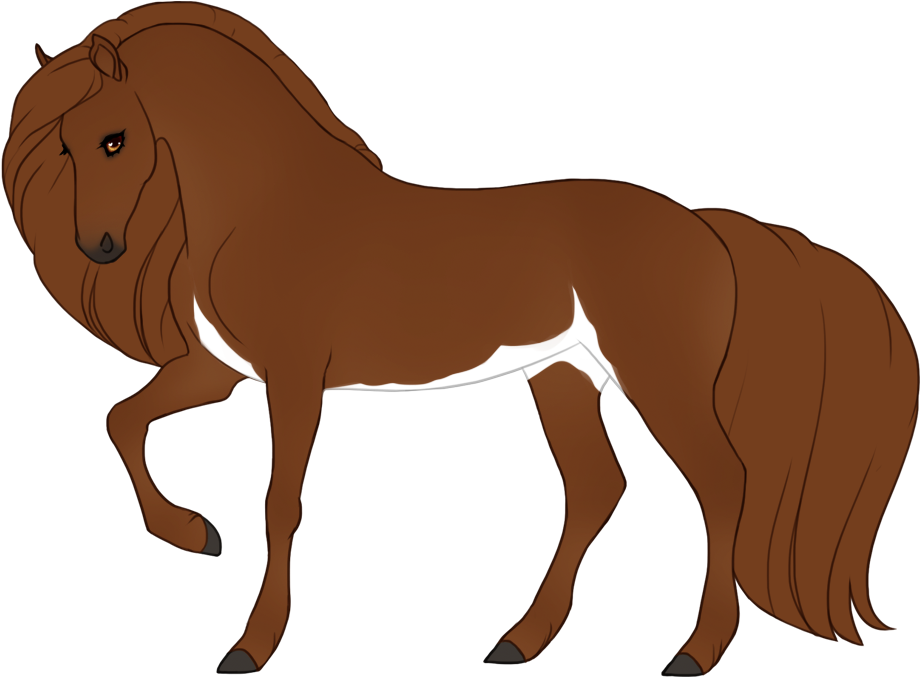
Minimal blaise
chestnut + blaise
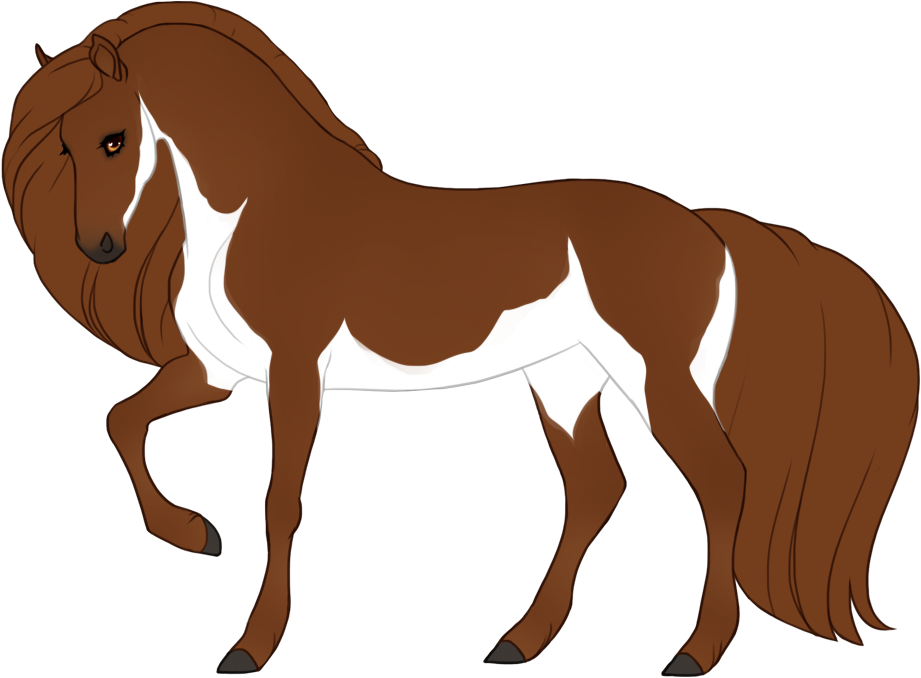
Blaise
chestnut + blaise
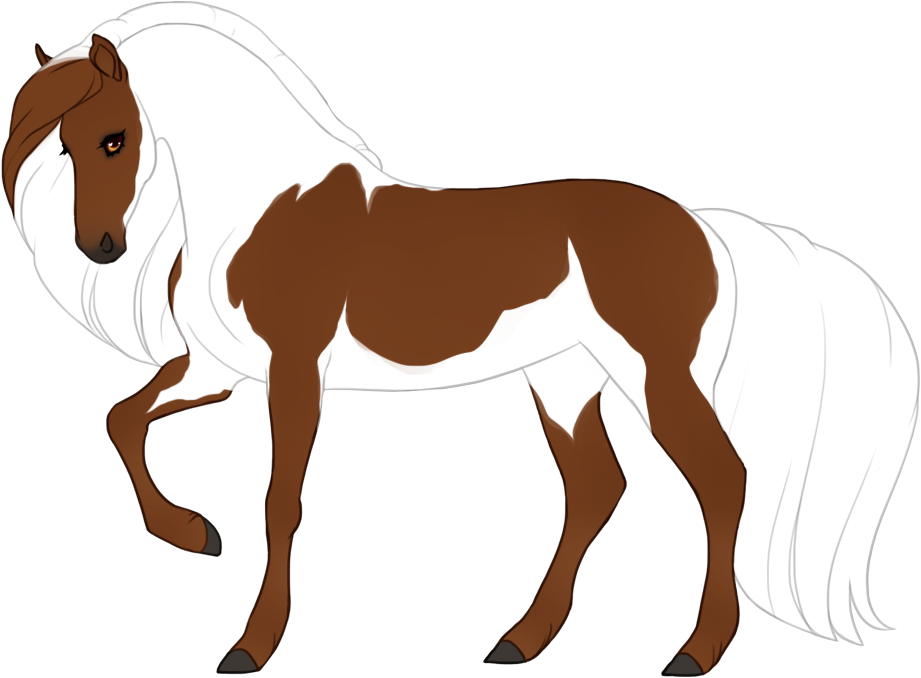
Collared blaise
chestnut + blaise
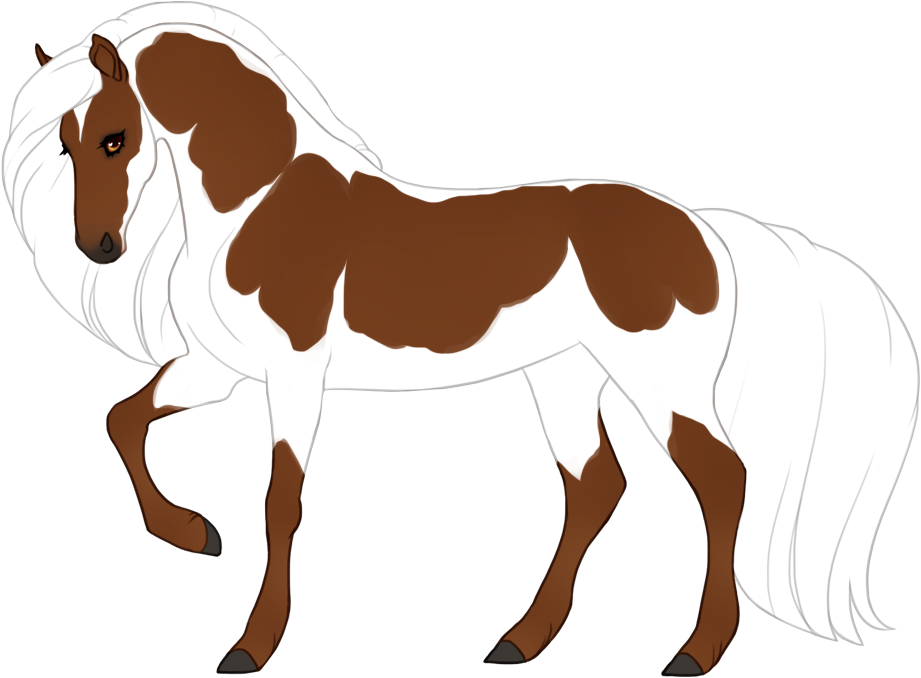
Topline blaise
chestnut + blaise
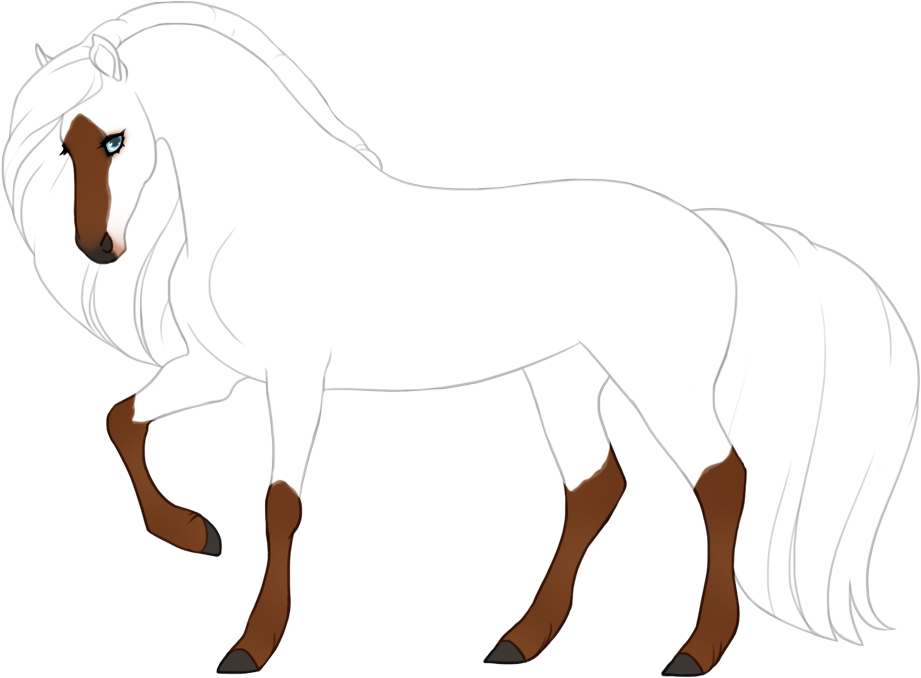
Maximal blaise
chestnut + blaise
Overo
OO / nO
Effects
- Skin: skin will be light pink under any white patterns
- Horns and hooves: hooves will be light where white leg markings connect [Horn & hoof color guide]
- Eye color: eyes can optionally be blue even if white facial markings do not reach them, and will always be blue if white markings do reach. [Eye color guide]
Appearance
Overo (also known as Frame Overo) causes irregular white patterns on the sides, surrounded by a "frame" of the base color of the horse.
White markings on the face and legs are optional, overo white markings are allowed to extend down the legs but it is not required.
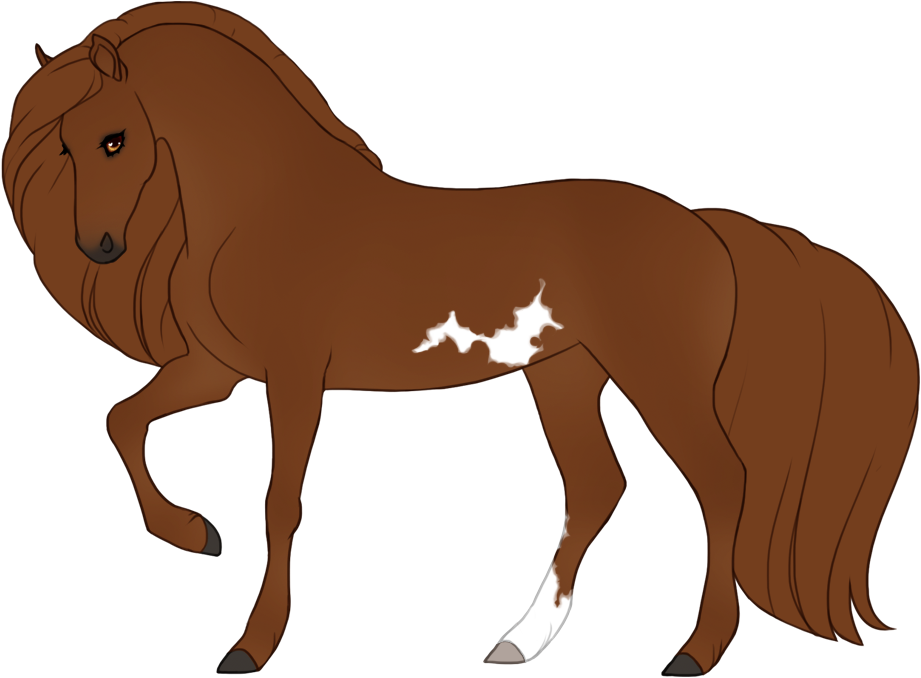
Minimal overo
chestnut + overo
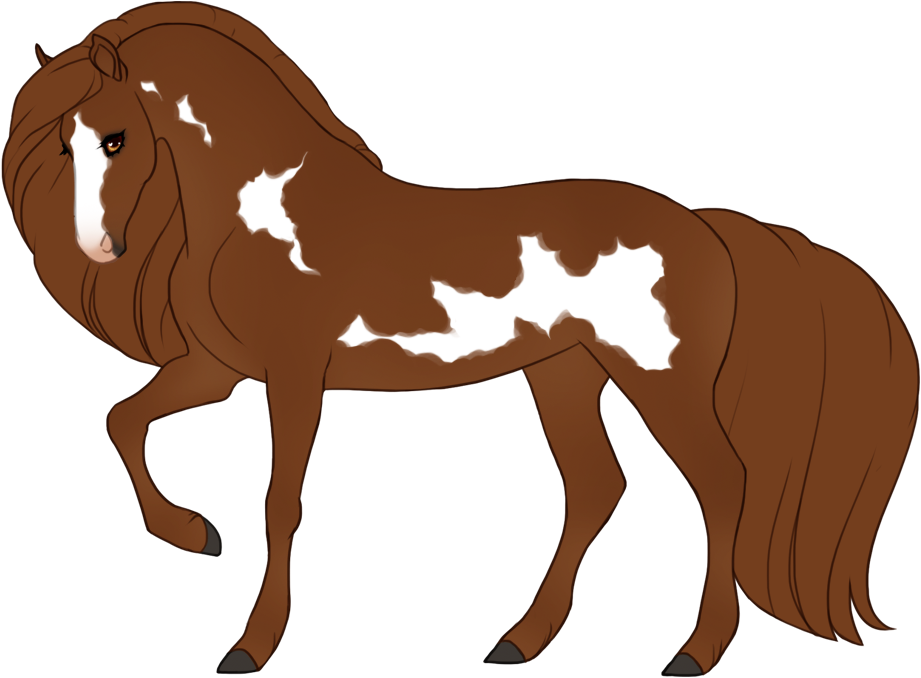
Overo
chestnut + overo
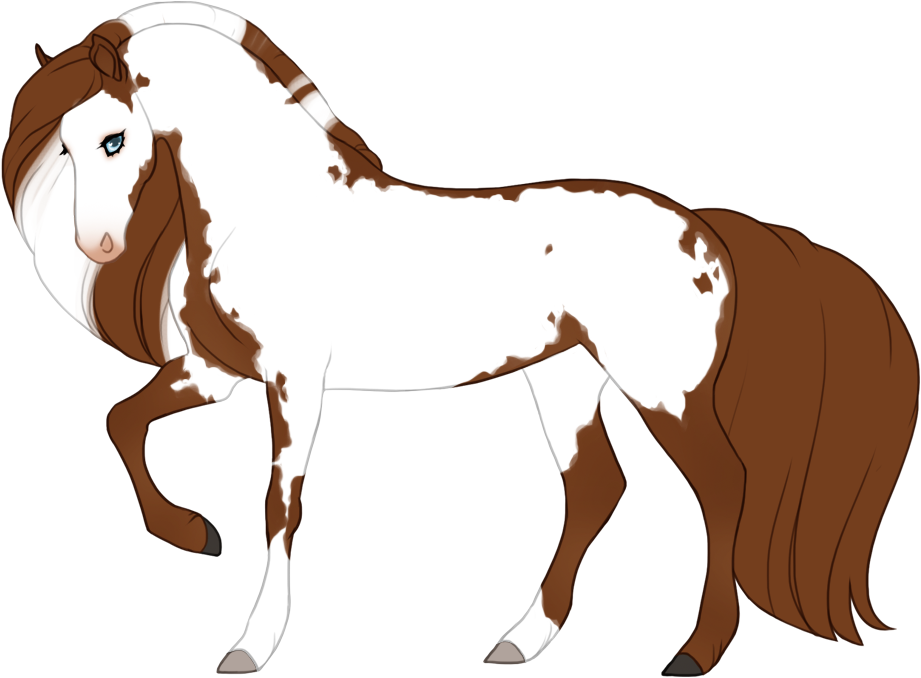
Maximal overo
chestnut + overo
Optional effect: Badger face
Both sabino and overo can have the badger face marking, causing the white facial marking to have occluded spots, appearing as reversed blazes or white stripes along the sides of the head.

Broken badger face
chestnut + overo

Asymmetrical badger face
bay + overo

Thin lined badger face
chestnut + overo

Thick lined badger face
chestnut + overo

Half badger face
bay + overo

Occluded blaze badger face
chestnut + overo

Reversed badger face
chestnut + overo
Dominant white
WW / nW
Effects
- Skin: skin will be light pink under any white patterns
- Horns and hooves: hooves will be light where white leg markings connect [Horn & hoof color guide]
- Eye color: eyes can optionally be blue. light red/pink/salmon/golden eyes are allowed on pseudo-albino dominant white. [Eye color guide]
Appearance
Dominant white causes the horse to have fully white hairs and pink skin throughout the entire coat, regardless of any other present patterns.
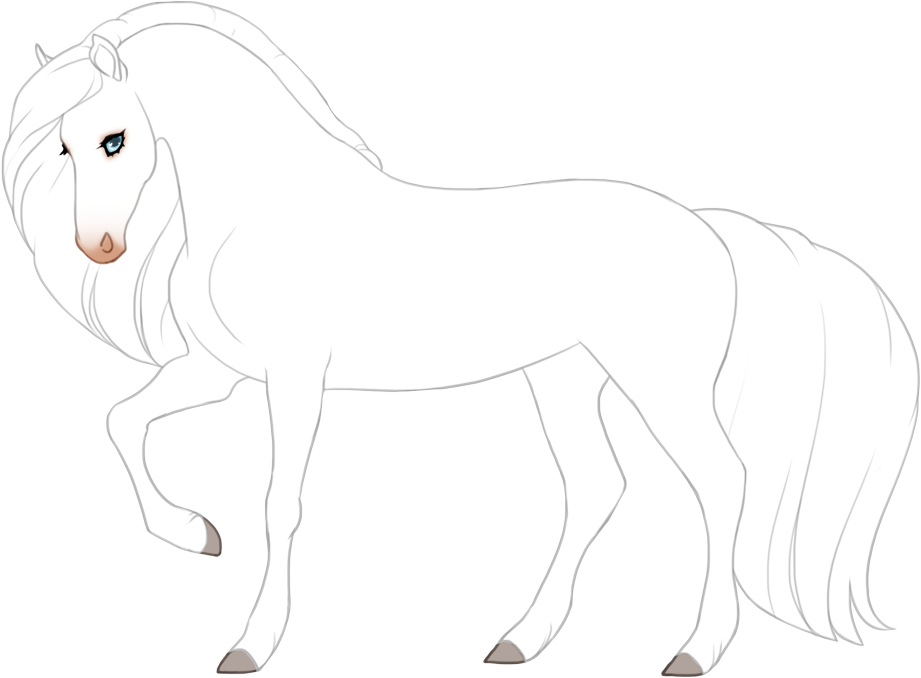
Dominant white
chestnut + dominant white
Optional effect: Pseudo-albino
Dominant white can optionally appear as a near-opaque white layer instead - on top of the underlying color and patterns, causing even a black coat to appear as a bright, near-white pink/peach/yellow with soft pink skin. Other white patterns will still appear as white.
Pseudo-albino will always be in the pink/orange/yellow color range, regardless of other dilutes and base colors. The only exception is if the Blue dilute is present, then you may choose if the coat is pink/orange/yellow or more grey/slate blue. The skin may still (optionally) be pink on a pseudo-albino blue horse, including pink eyes and pink/beige hooves.
Pseudo-albino causes the hooves to be pink or light beige, and the eyes to be light red/pink/salmon/golden.
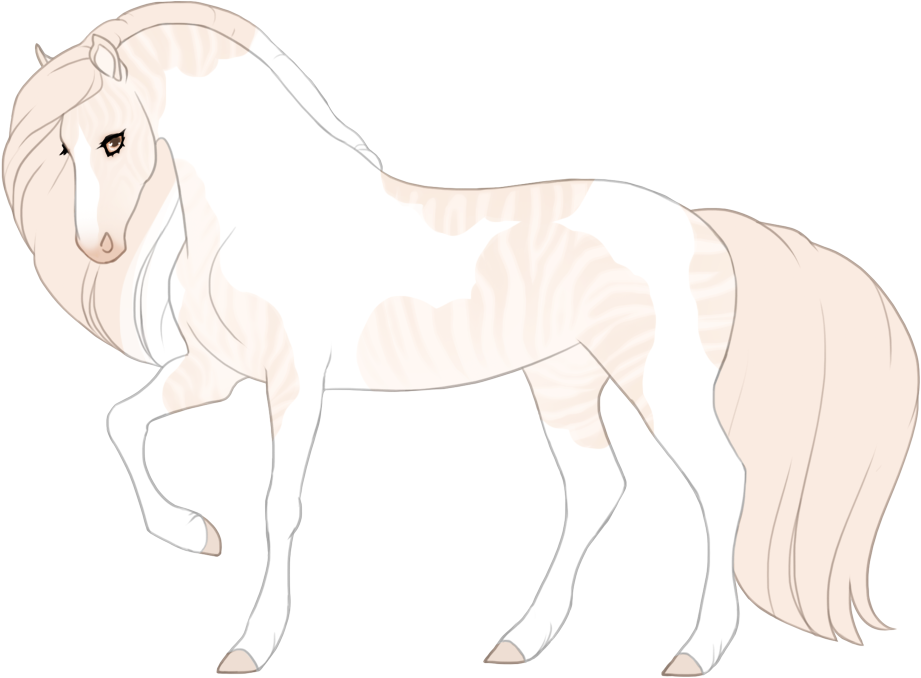
Pseudo-albino dominant white on chestnut dun tobiano with primitive markings
chestnut + dun + tobiano + dominant white
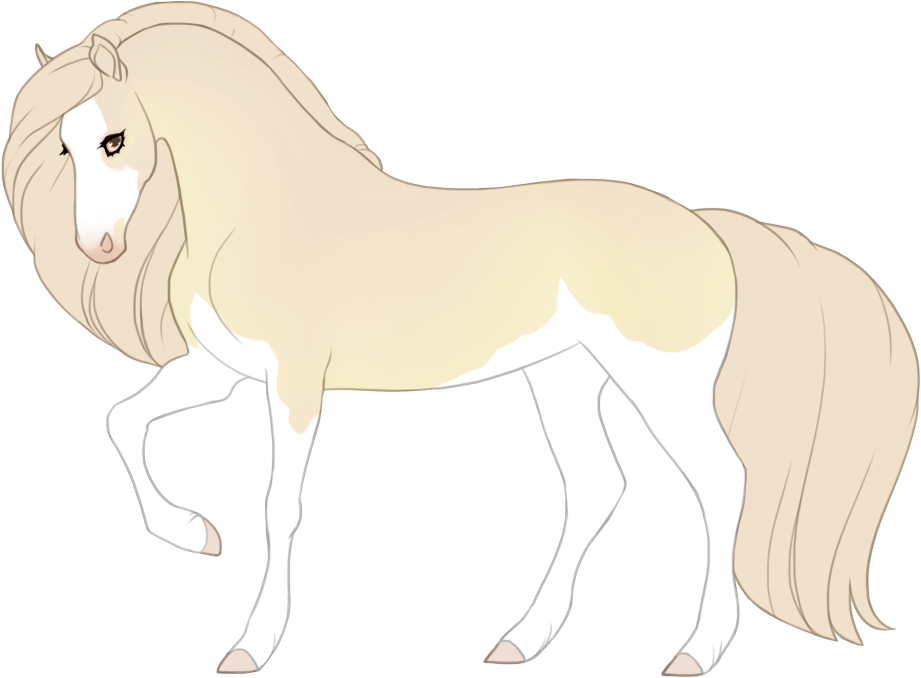
Pseudo-albino dominant white on seal bay splash
seal bay + splash + dominant white
Roan
RnRn / nRn
Effects
- Skin: no effect on skin
- Horns and hooves: no effect on hoof color [Horn & hoof color guide]
- Eye color: no effect on eye color [Eye color guide]
Appearance
Roan causes the coat on the body to have evenly mixed white and colored hairs.
Roan does not affect the mane or tail, and generally avoids the head and legs
The amount of white hairs varies between each horse, as well as the "even-ness" - it can appear slightly varnished or textured.
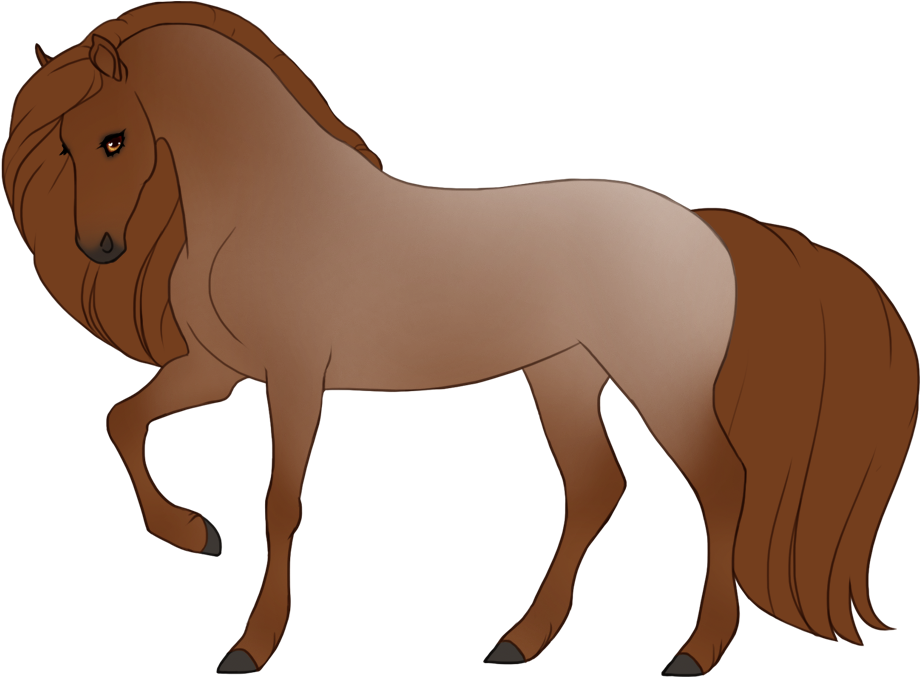
Minimal roan
chestnut + roan
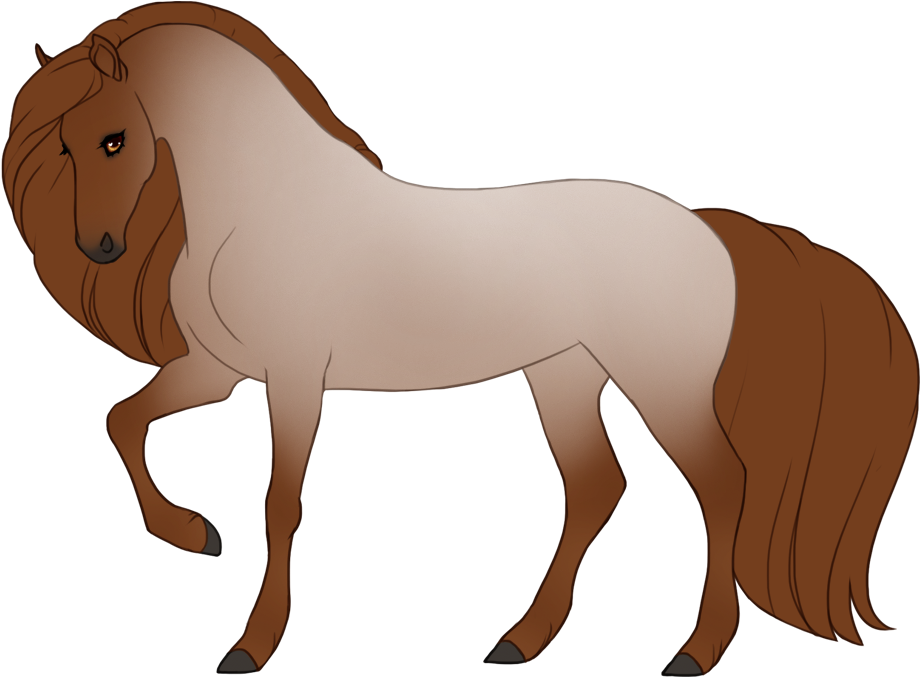
Roan
chestnut + roan
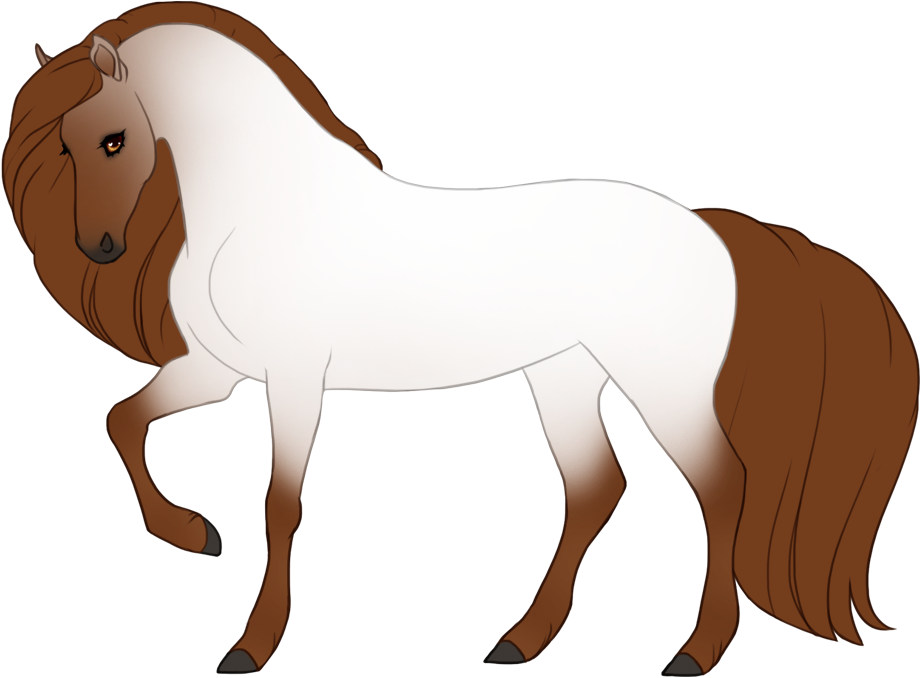
Maximal roan
chestnut + roan
Optional effect: Corn spots
Corn spots on roan causes small "holes" in the roaning where the base coat is visible.
Additionally, on roaned horses scars and injuries can have the fur grow back in the same color as the base coat, without roaning.
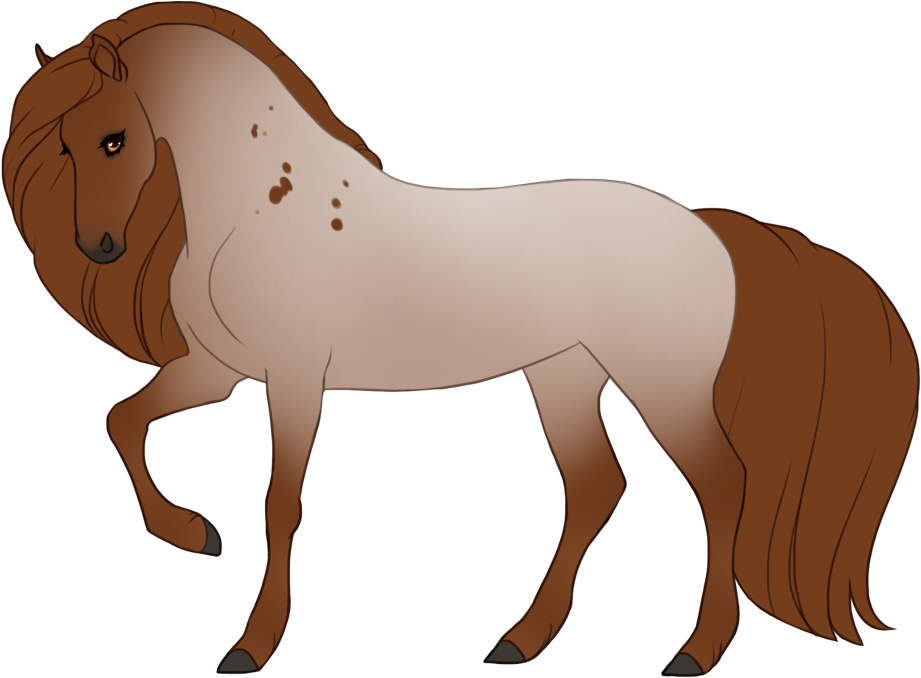
Roan with cornspots
chestnut + roan
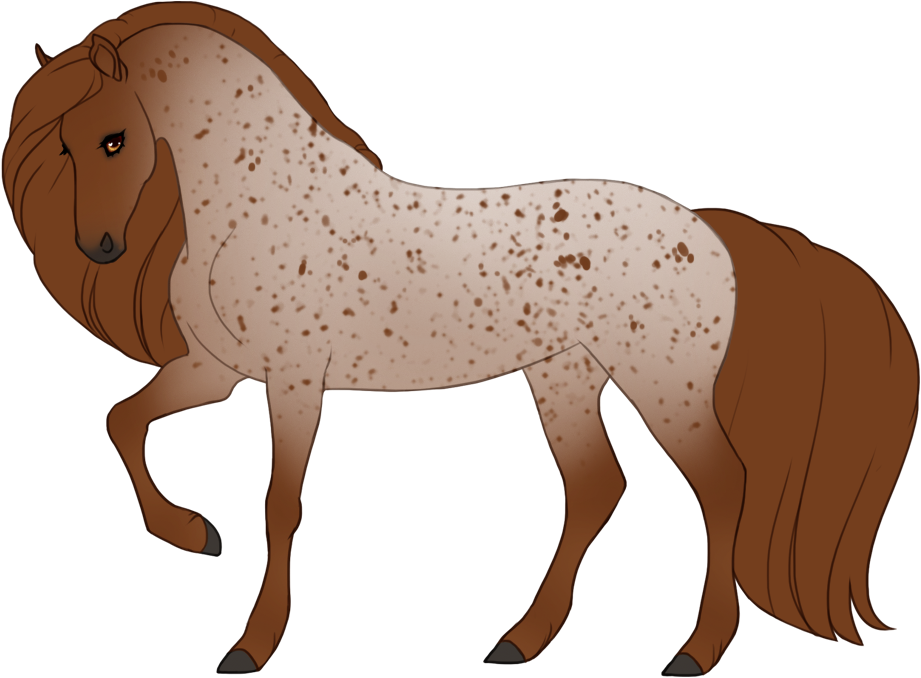
Roan with many small cornspots
chestnut + roan
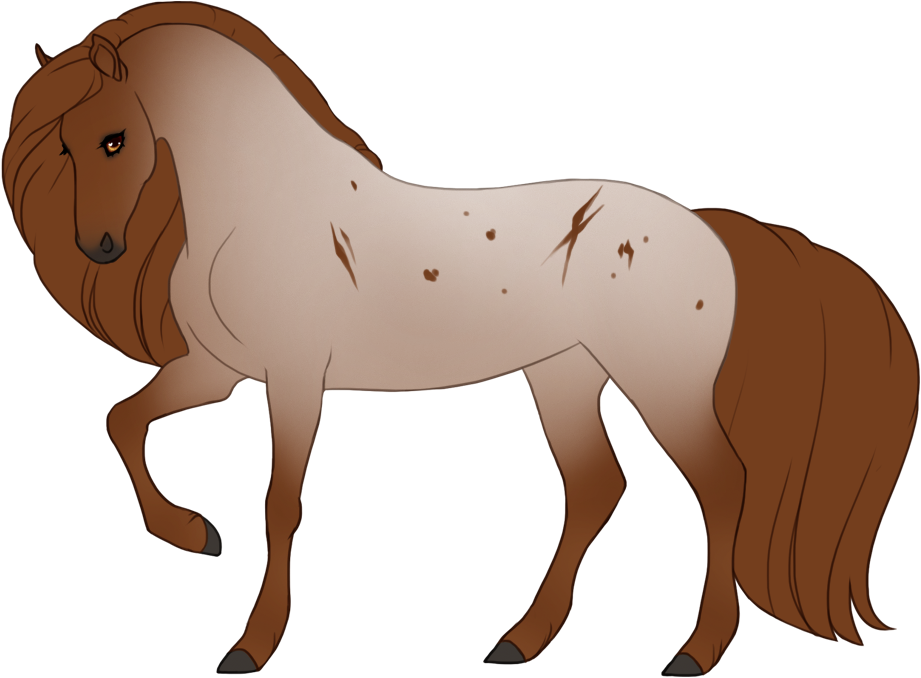
Cornspots and scarring
chestnut + roan
Optional effect: Reverse dapples
Roan can have a reversed dapple effect, with dark dapple spots on the roaned areas. These dapples can be anywhere from just subtly darker, to completely showing the basecoat underneath. A roan with heavy dapple effect can appear as white lacing on the coat, as shown on the third example.
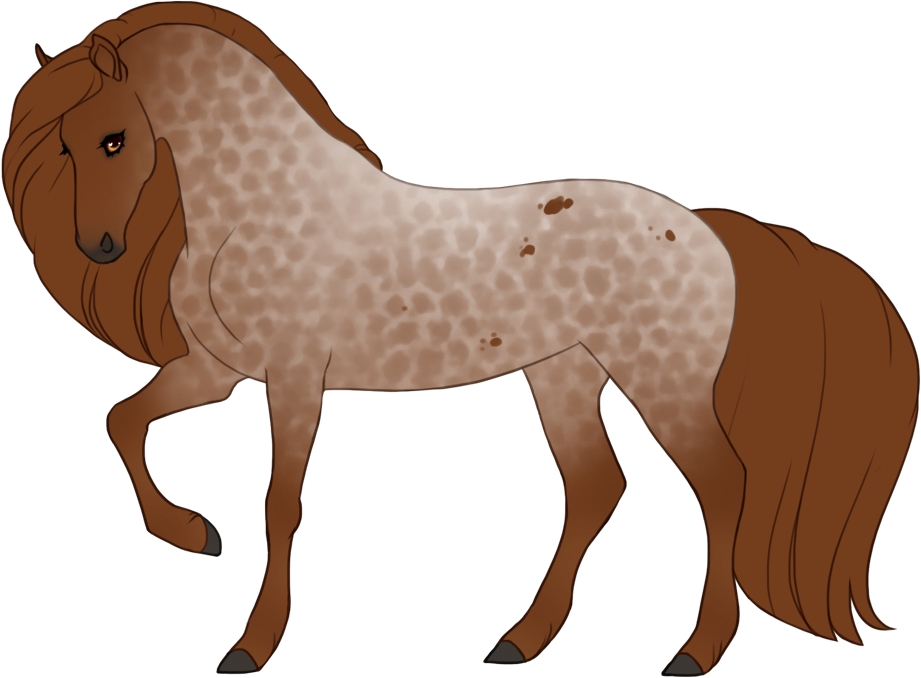
Roan with subtle reverse dappling and corn spots
chestnut + roan
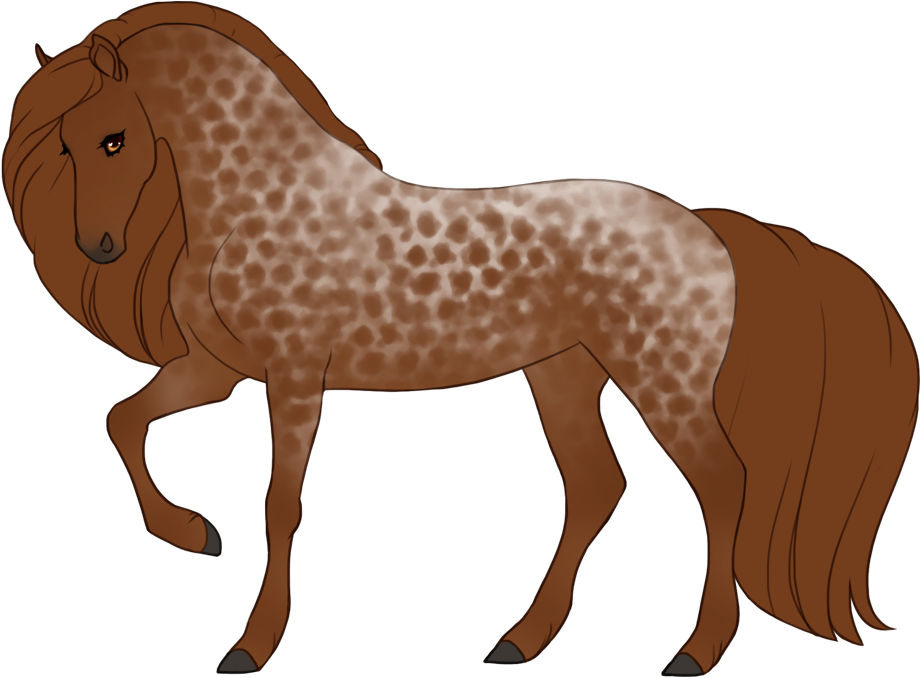
Roan with reverse dappling
chestnut + roan
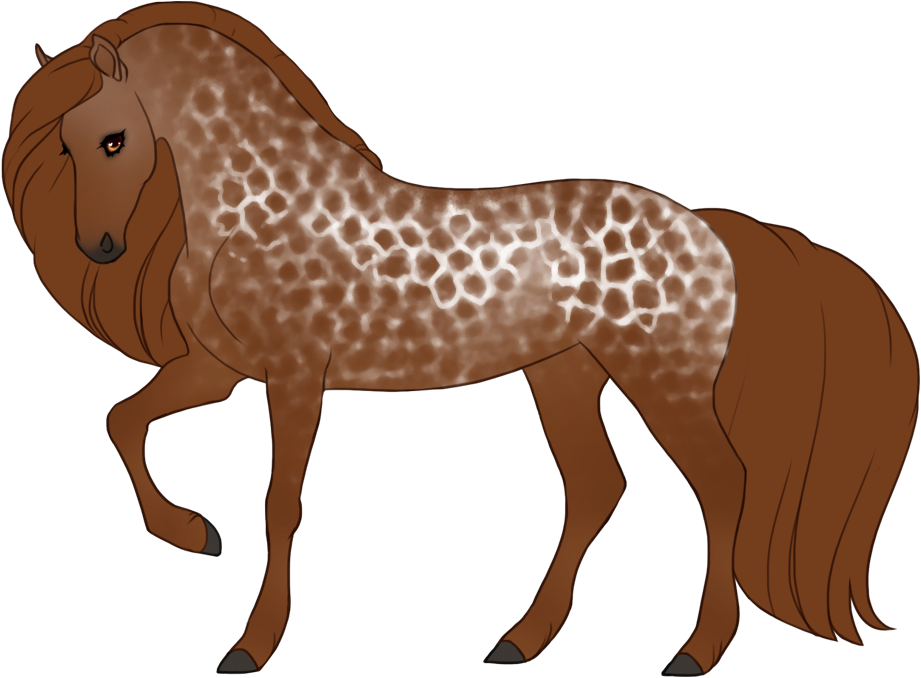
"Laced" roan with reverse dappling
chestnut + roan
Rabicano
RbRb / nRb
Effects
- Skin: skin will be light pink under any white patterns
- Horns and hooves: hooves will be light where white leg markings connect [Horn & hoof color guide]
- Eye color: no effect on eye color [Eye color guide]
Appearance
Rabicano has a similar appearance to roan with white hairs mixed with the colored coat, but has a more brindled or striped appearance and starts from the flank, elbow and throat area.
Rabicano starts from the belly and reaches upwards, and can connect to the topline.
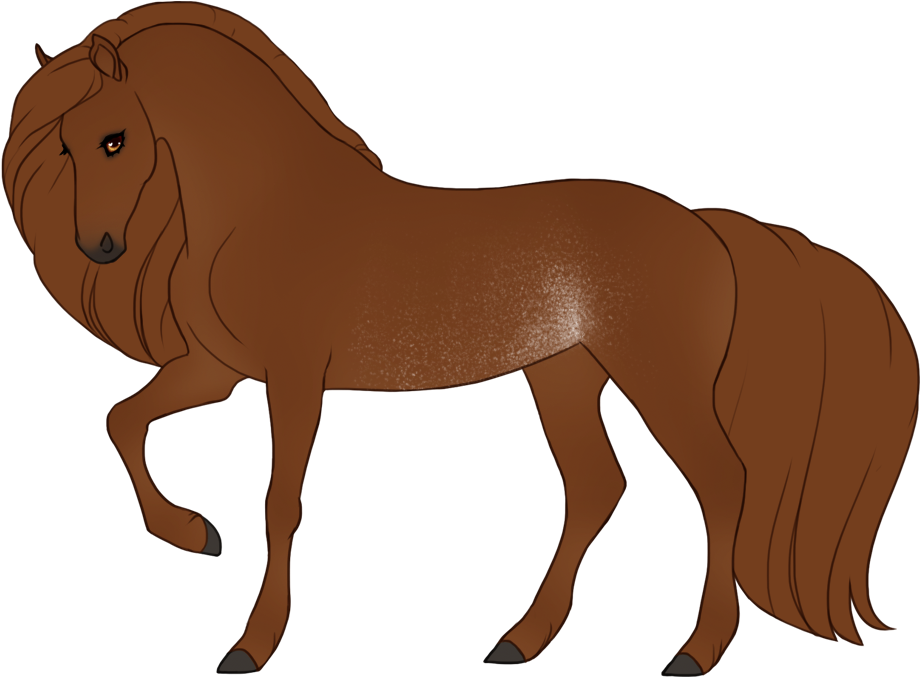
Minimal rabicano
chestnut + rabicano
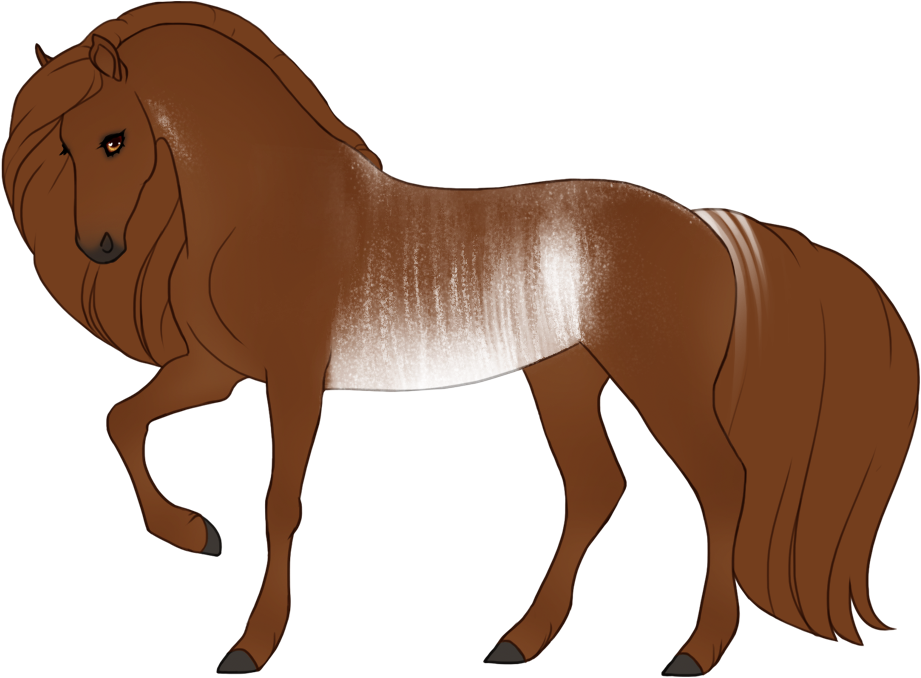
Rabicano
chestnut + rabicano
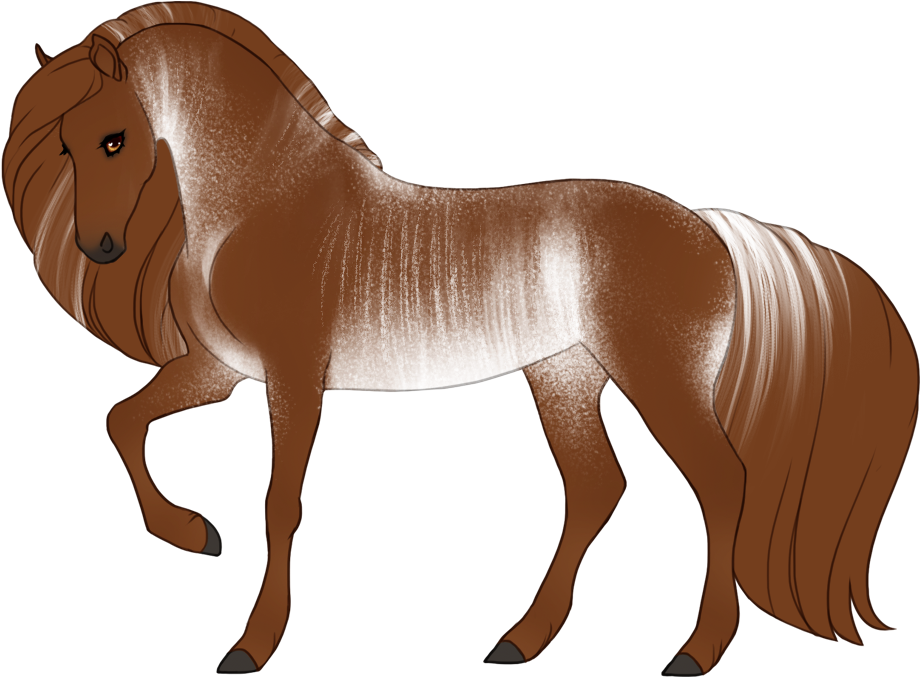
Maximal rabicano
chestnut + rabicano
Optional effect: Skunk tail
An iconic characteristic of rabicano is the "skunk tail" that causes white striping in the tail.
It can appear as white hairs on the outside edges of the tail similar to dun frosting, or as horizontal white striping along the tail, or both.
Skunk tail markings/stripes can optionally extend further along the back, as shown in the 2nd and 3rd example images.
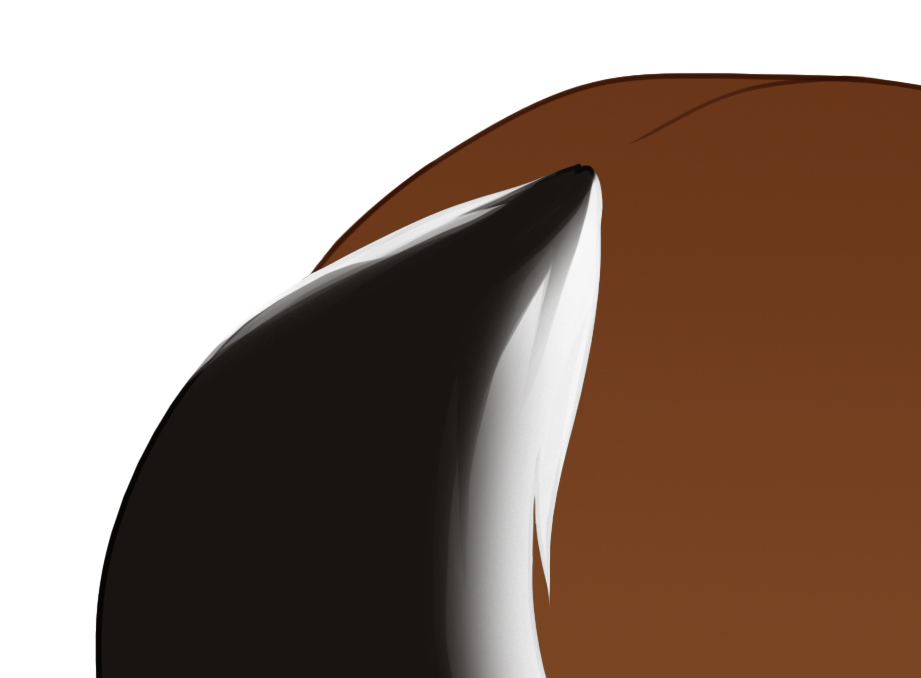
Skunk tail
bay + rabicano
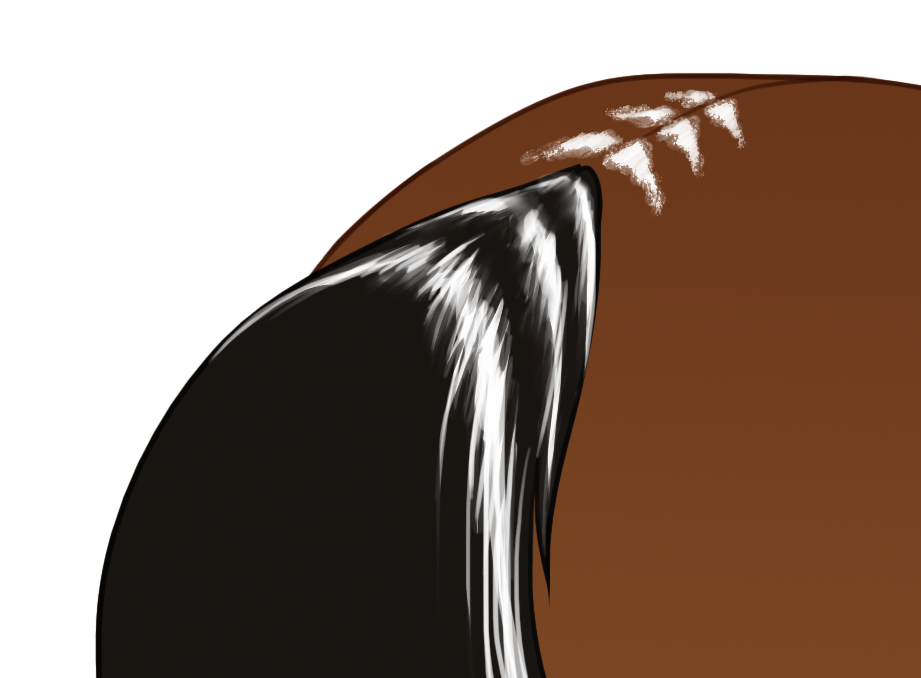
Raccoon tail with white tail stripes
bay + rabicano
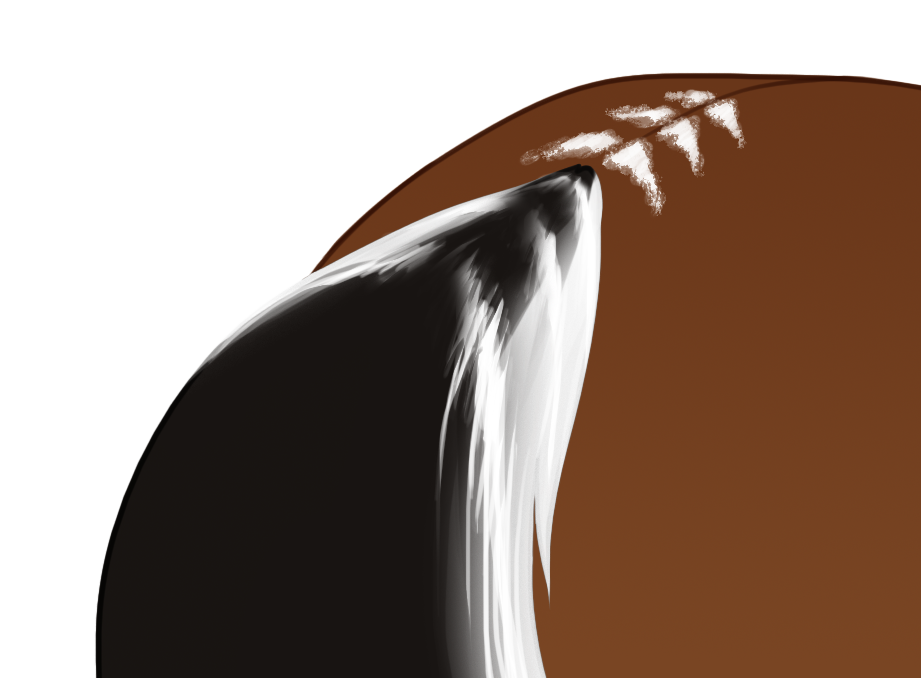
Skunk tail with raccoon stripes
bay + rabicano
Mottle
MtlMtl / nMtl
Effects
- Skin: skin will be light pink under any white patterns, and can optionally be freckled/mottled even if no white spots are near
- Horns and hooves: hooves will be light where white leg markings connect, and can optionally be striped even if no white spots are near [Horn & hoof color guide]
- Eye color: no effect on eye color [Eye color guide]
Appearance
Mottle causes white spots of varying sizes anywhere on the body. The size can be anywhere from as small as freckles to large spots similar to leopard appaloosa.
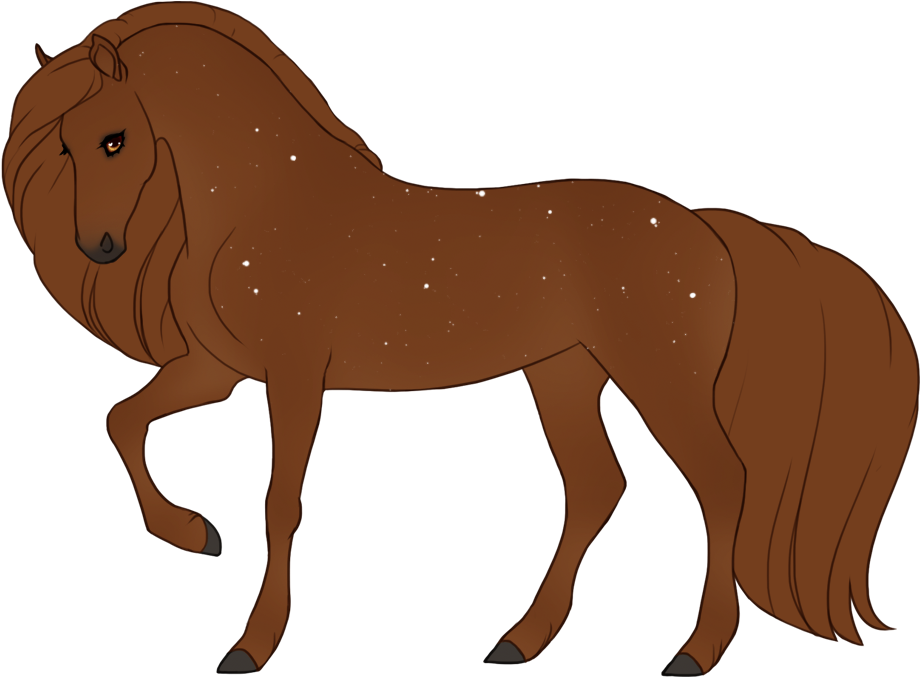
Minimal mottle
chestnut + mottle
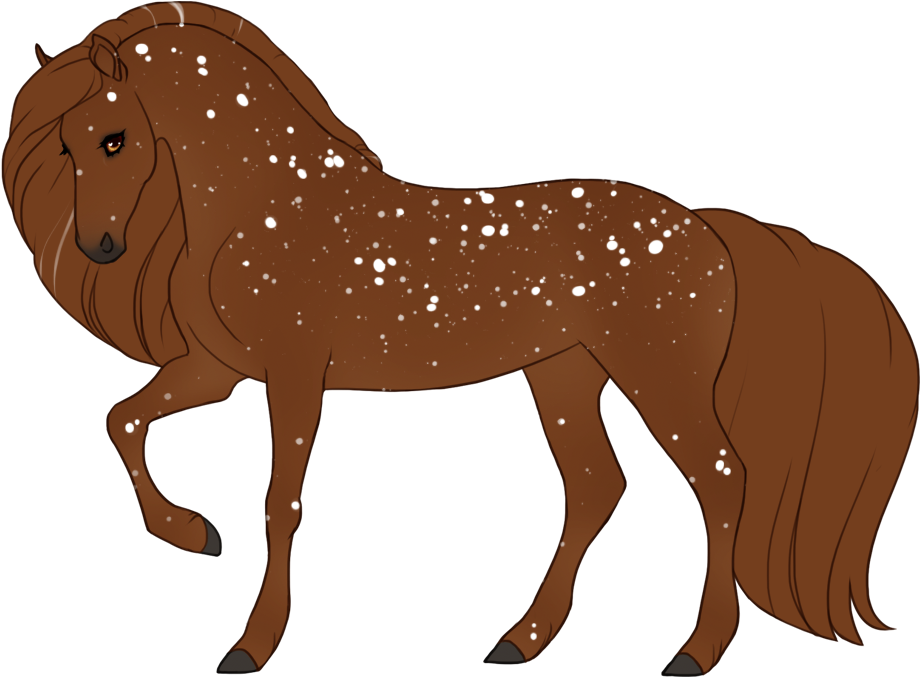
Mottle
chestnut + mottle
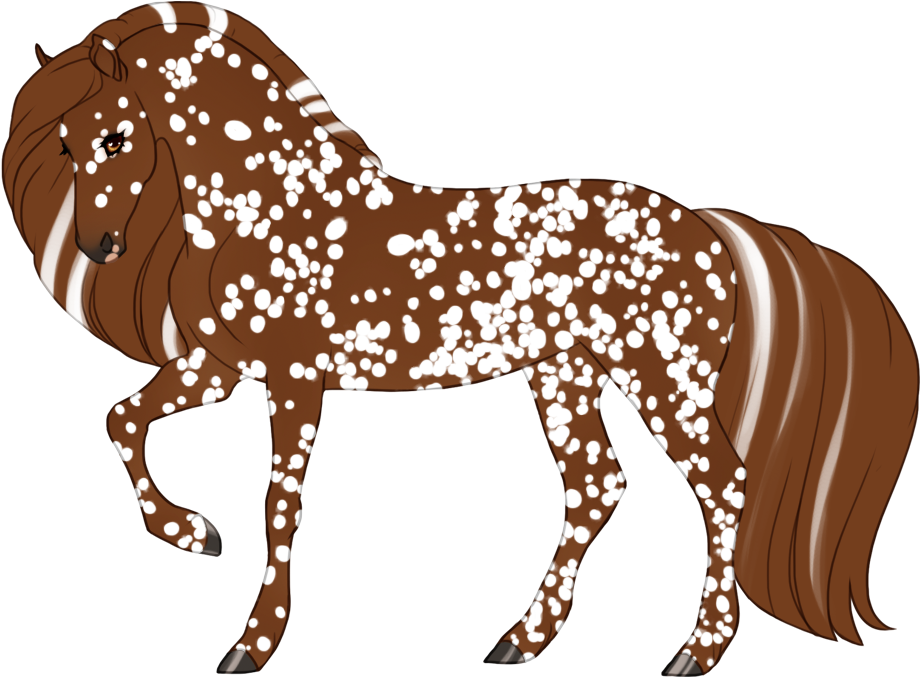
Maximal mottle
chestnut + mottle
Optional effect: Clumping
Mottled spots can clump together and form any pattern, as long as they are still recognizable as clumped spots and not stripes/markings with "clean" straight edges.
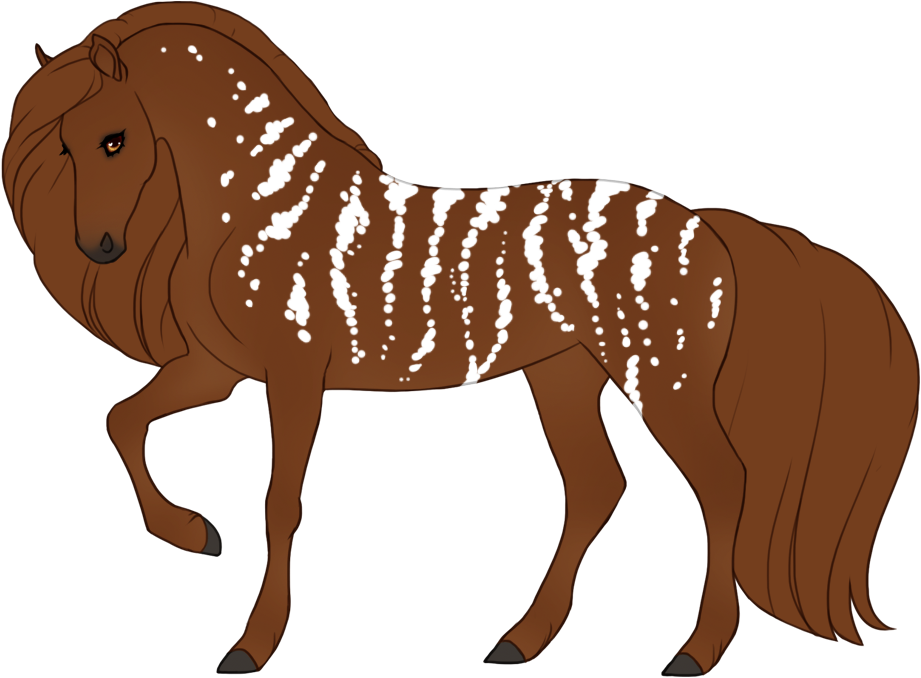
Mottled tiger stripes
chestnut + mottle
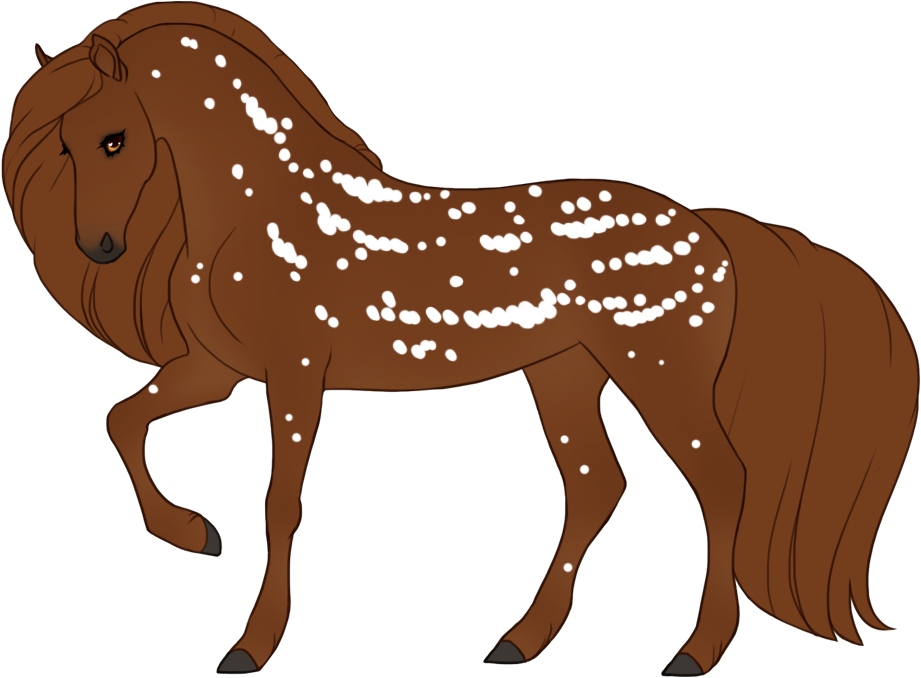
Mottled tapir/fallow stripes
chestnut + mottle
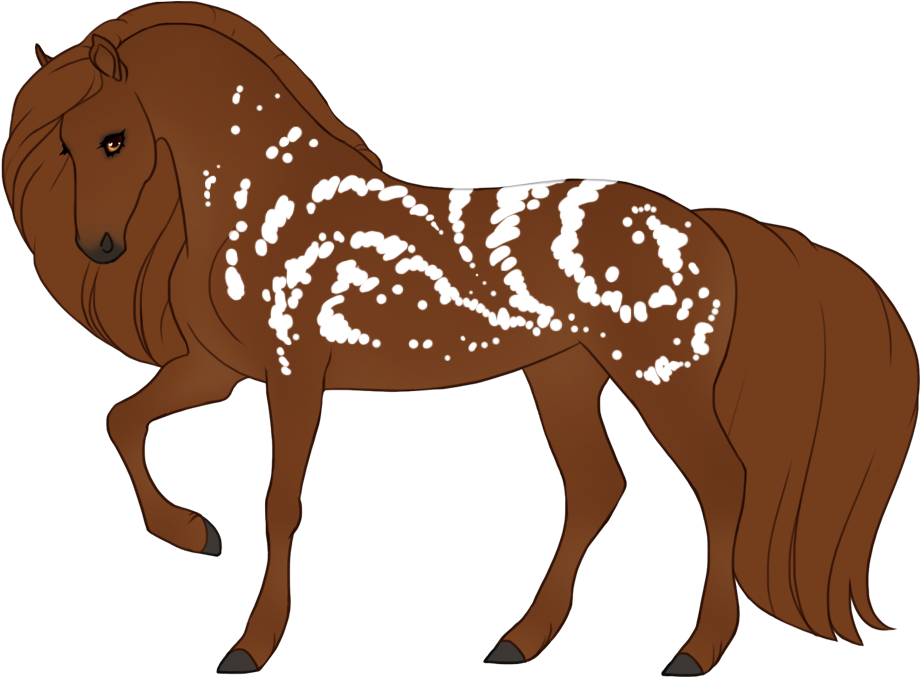
Mottled swirly stripes
chestnut + mottle
Effects
- Skin: skin will be light pink under any white patterns, and can optionally be freckled/mottled even if no white spots are near
- Horns and hooves: hooves will be light where white leg markings connect, and can optionally be striped even if no white spots are near [Horn & hoof color guide]
- Eye color: eyes can optionally be blue [Eye color guide]
Appearance
Leopard appaloosa causes white appaloosa patterns with many spots of varying sizes. The spots should appear as holes in the white markings, showing the base coat underneath.
Leopard appaloosa can have very roaned edges on the white markings.
Mane and tail will be affected where white markings touch, however in the case of a blanket pattern it is optional whether it affects the mane/tail or not.
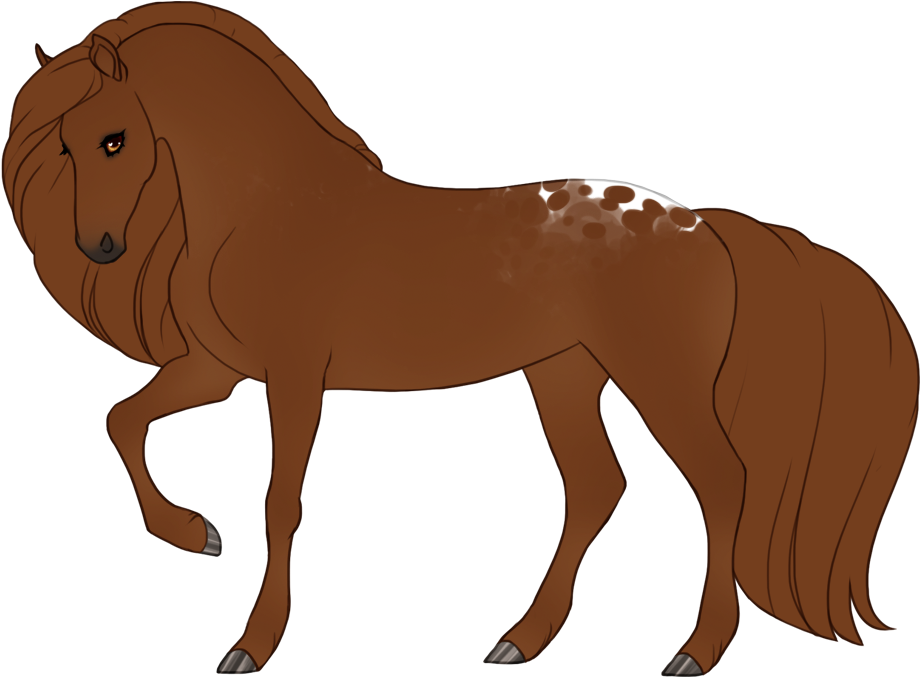
Minimal leopard appaloosa
chestnut + leopard appaloosa
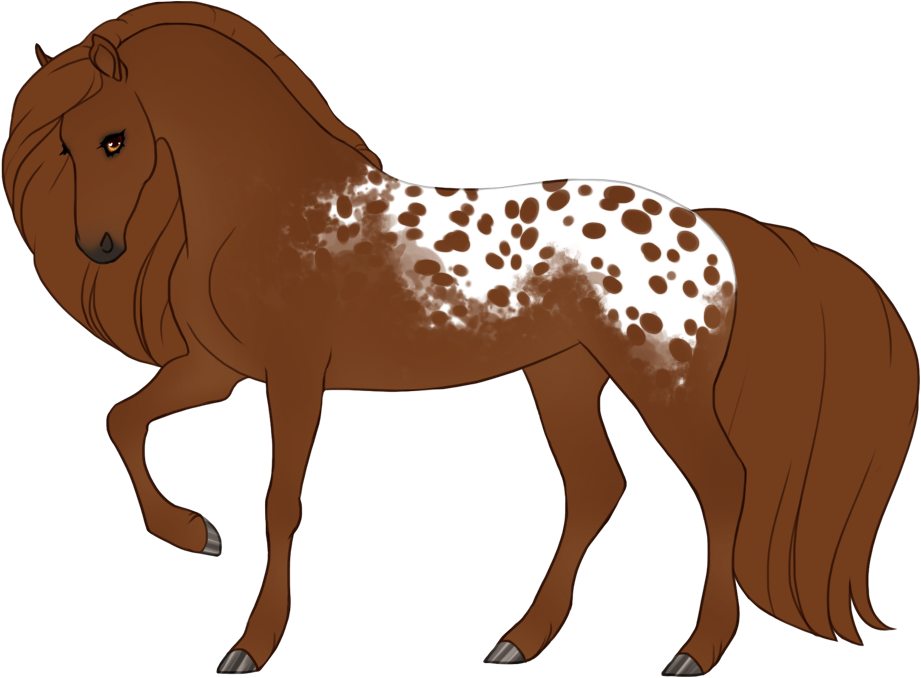
Blanket leopard appaloosa
chestnut + leopard appaloosa
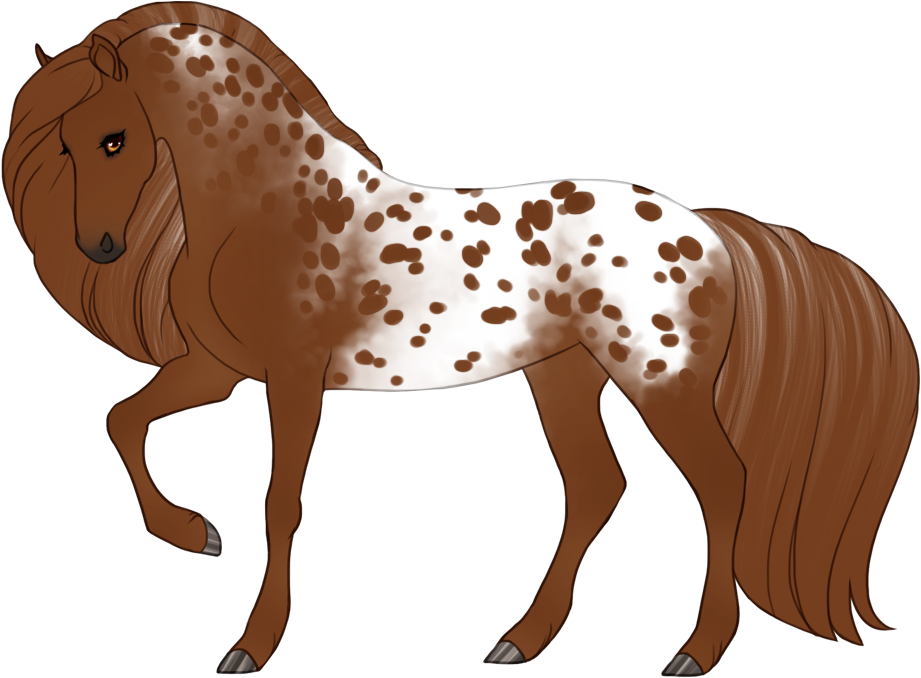
Semi-leopard appaloosa
chestnut + leopard appaloosa
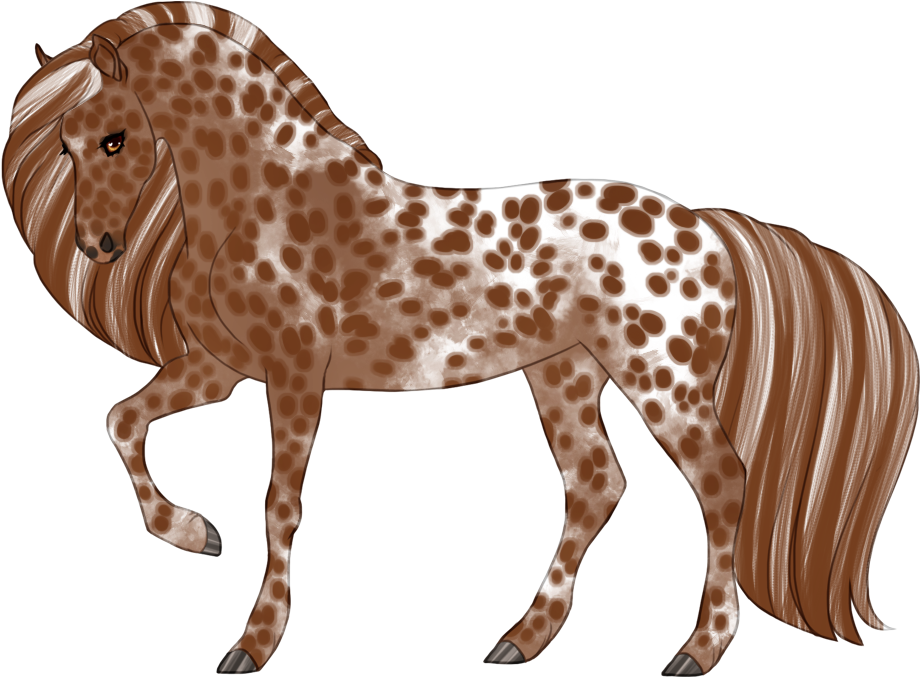
Near-leopard appaloosa
chestnut + leopard appaloosa
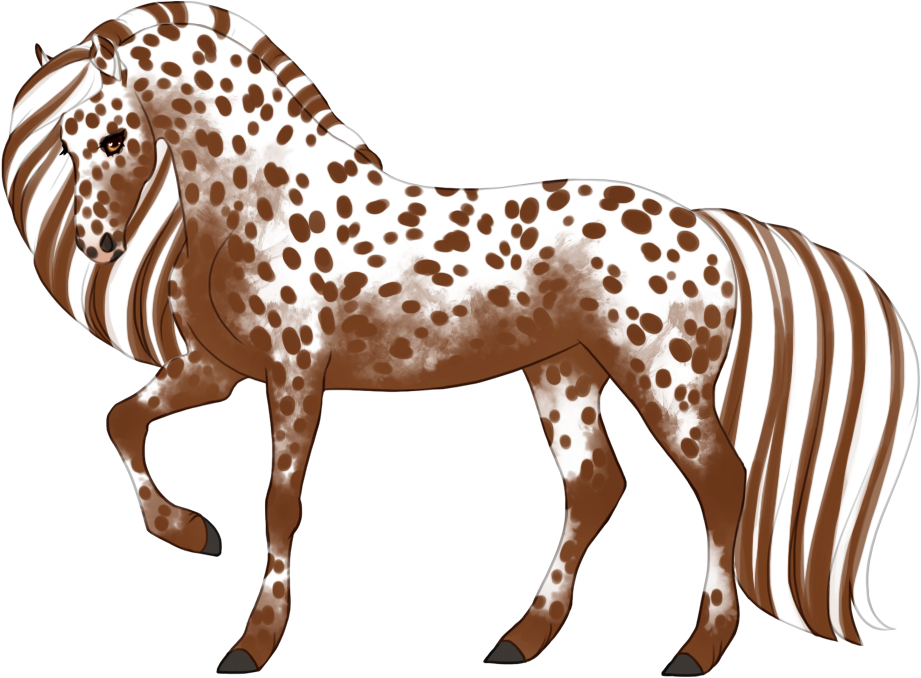
Near-leopard appaloosa
chestnut + leopard appaloosa
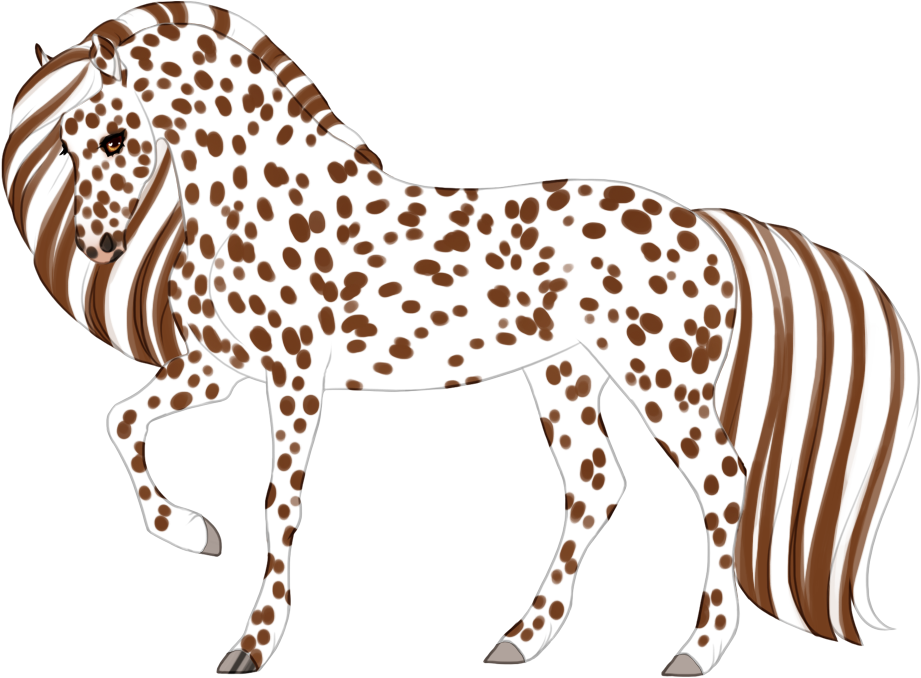
Leopard appaloosa
chestnut + leopard appaloosa
Optional effect: Dark spots
Leopard appaloosa can have much darker spots than the main coat present, filling in the holes in the pattern or even appearing outside.
Dark spots can optionally affect mane and tail where they touch.
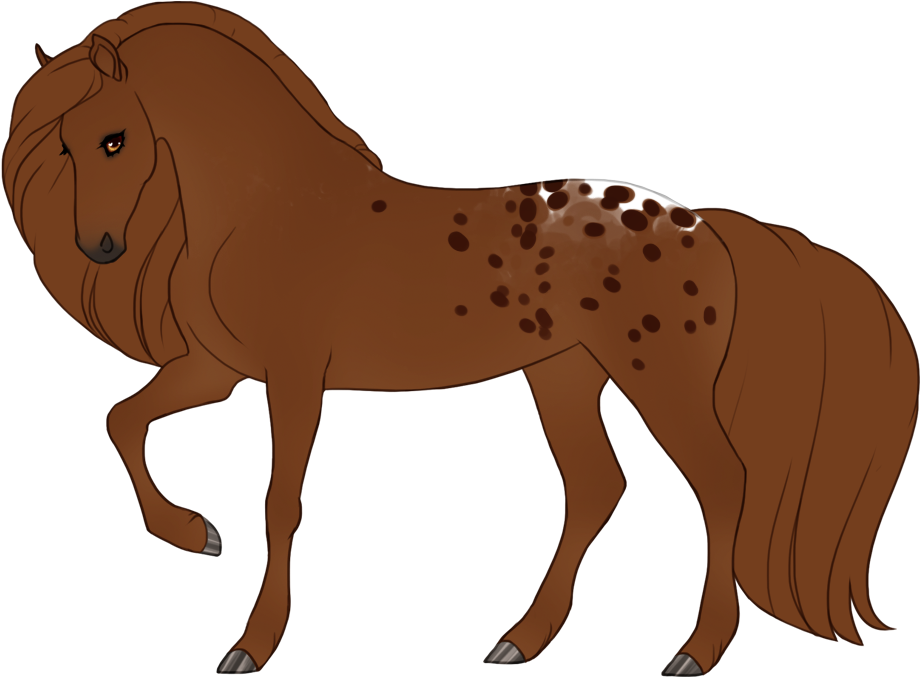
Dark spots visible outside blanket
chestnut + leopard appaloosa
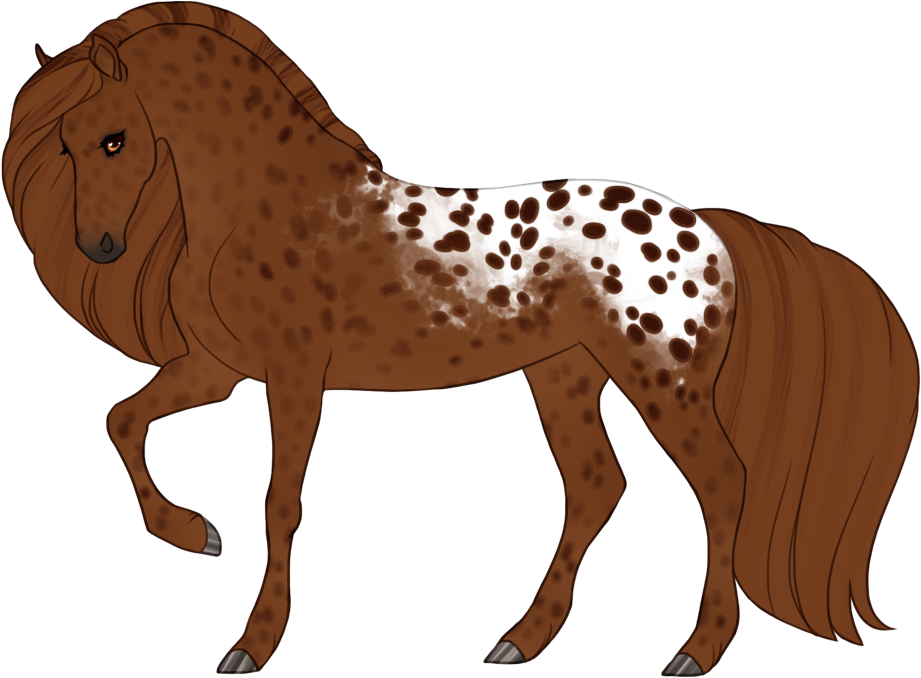
Dark spots on blanket, with semi-visible spots outside blanket
chestnut + leopard appaloosa
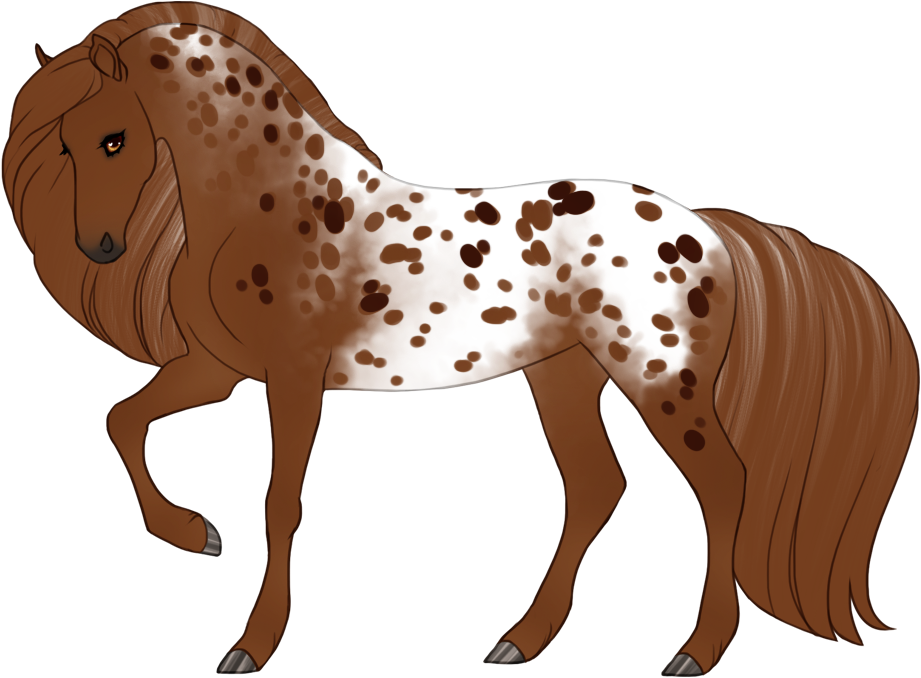
Semi-leopard with some dark spots
chestnut + leopard appaloosa
Optional effect: Snowflake
Snowflake causes a "reverse leopard" appearance, with white spots on a colored coat.
The white spots should be smaller than regular appaloosa spots, and can have a roaned appearance.
Snowflake appaloosa can be combined with other leopard appaloosa patterns, such as blanket leopard appaloosa and dark spots shown in the examples below.
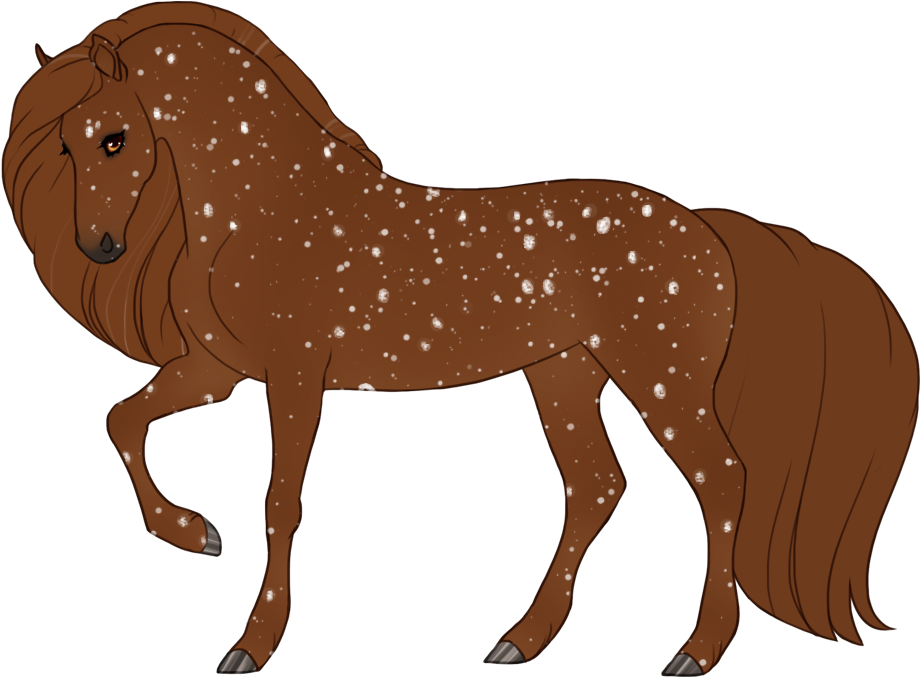
Snowflake leopard appaloosa
chestnut + leopard appaloosa
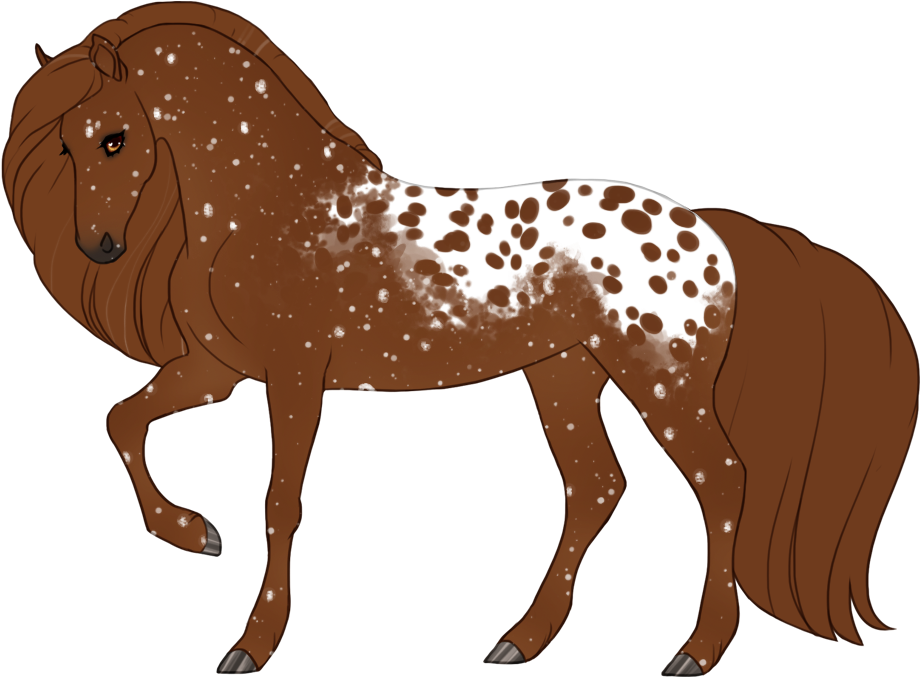
Snowflake blanket leopard appaloosa
chestnut + leopard appaloosa
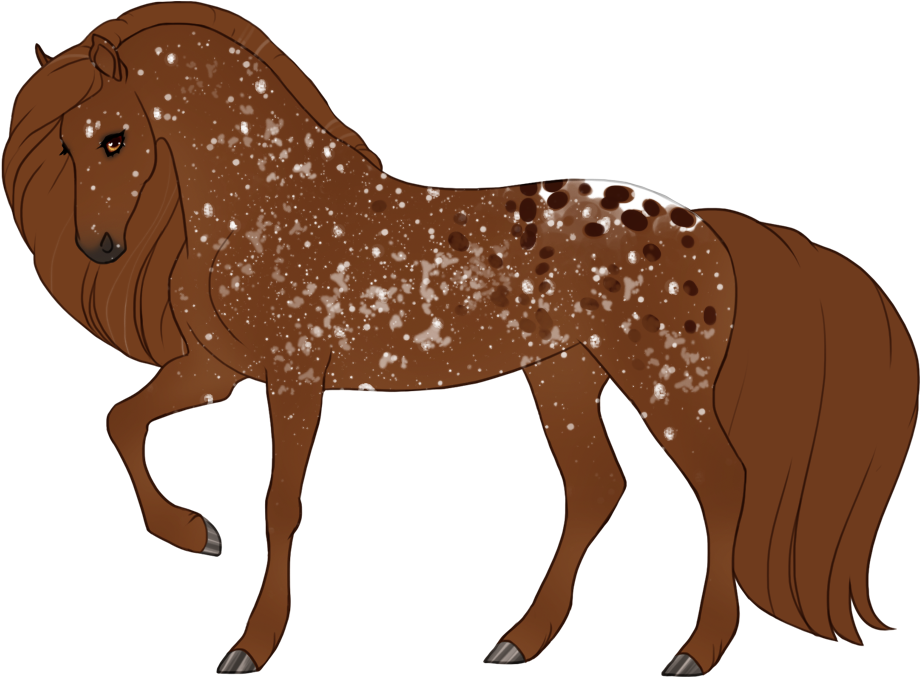
Snowflake minimal blanket leopard appaloosa with dark spots
chestnut + leopard appaloosa
Optional effect: Varnish
Leopard appaloosa can have a varnished appearance, with a heavily roaned uneven pattern as if the white has been sandpapered off.
There should still be a spotted leopard pattern present on varnished leopard appaloosa, or snowflake appaloosa spots.
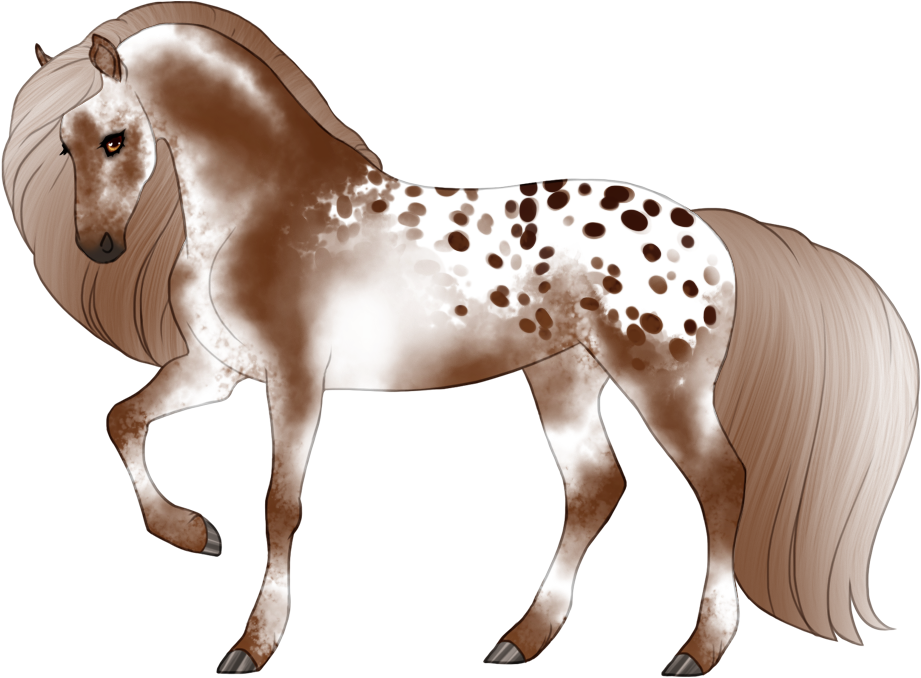
Varnished blanket leopard appaloosa with dark spots
chestnut + leopard appaloosa
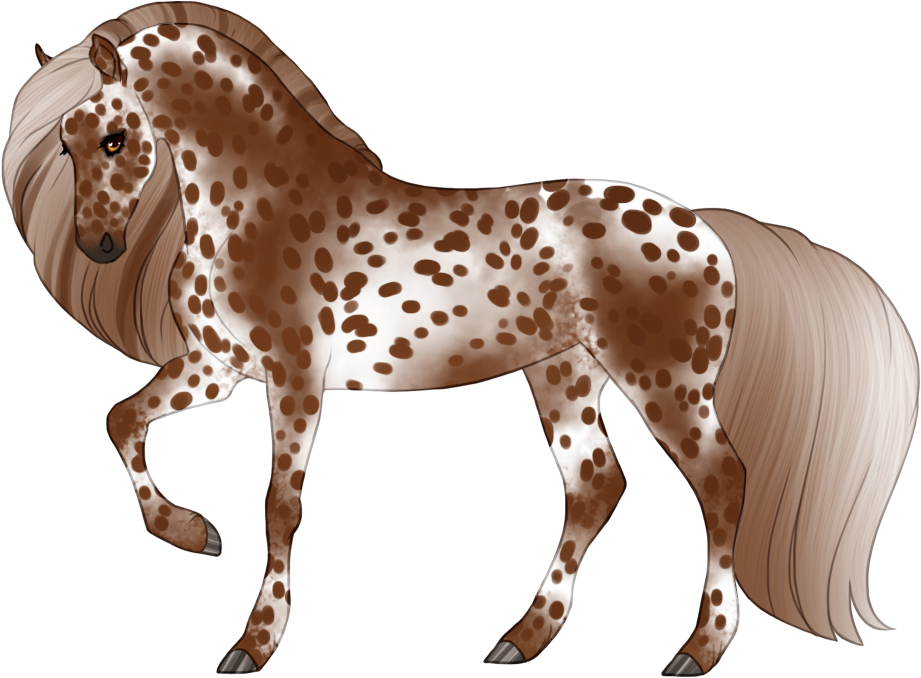
Varnished leopard appaloosa
chestnut + leopard appaloosa
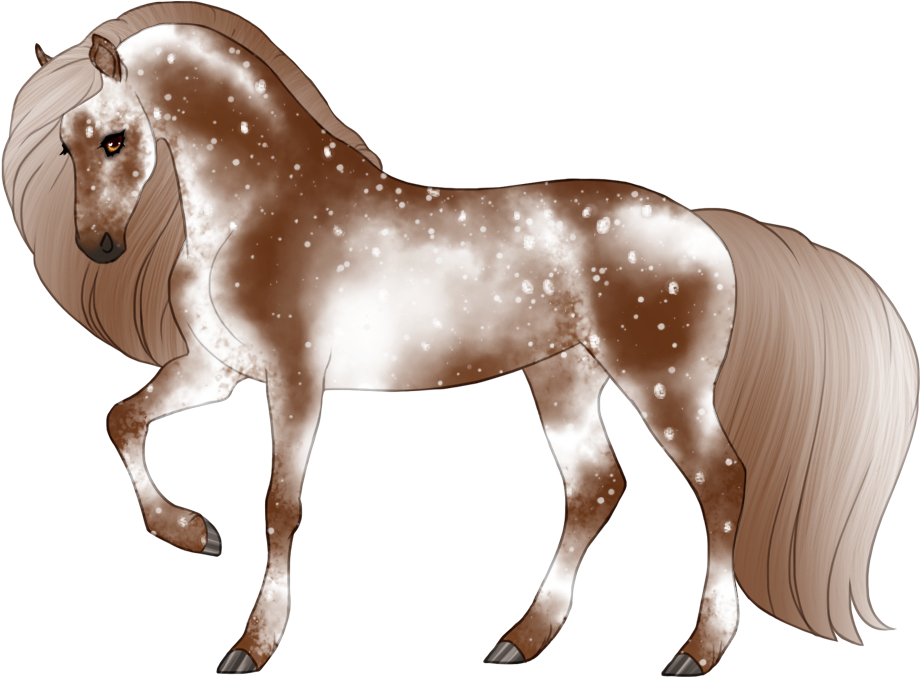
Varnished snowflake leopard appaloosa
chestnut + leopard appaloosa
Optional effect: Mismarked
Mismarked appaloosa causes random areas to be absent of white, or have the dark spots/holes clumped together so tightly that they form larger splotches of color.
Mismarked can appear anywhere on the body and in any size.
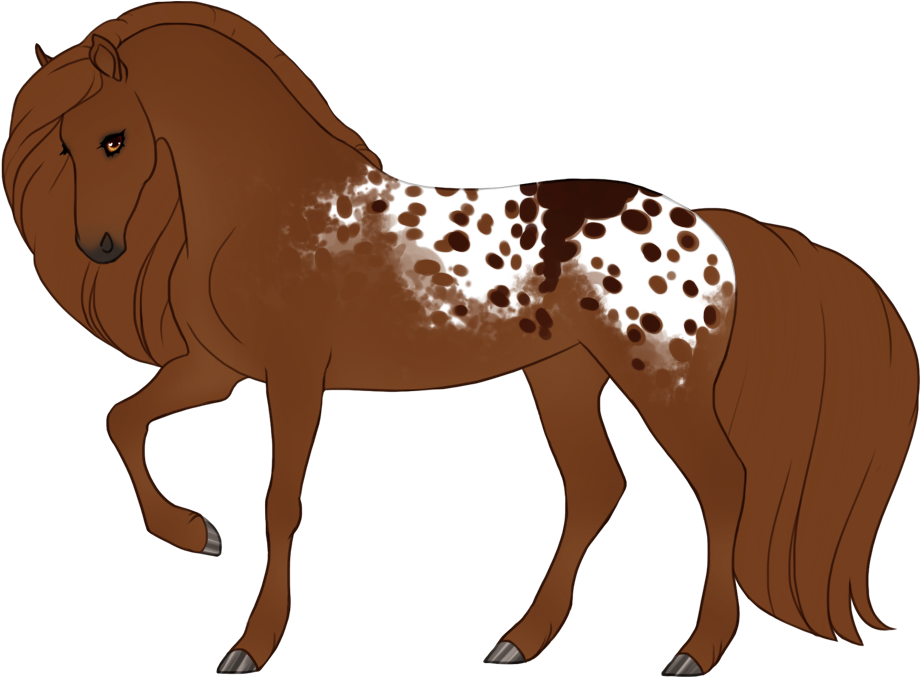
Leopard blanket with mismarked dark spots
chestnut + leopard appaloosa
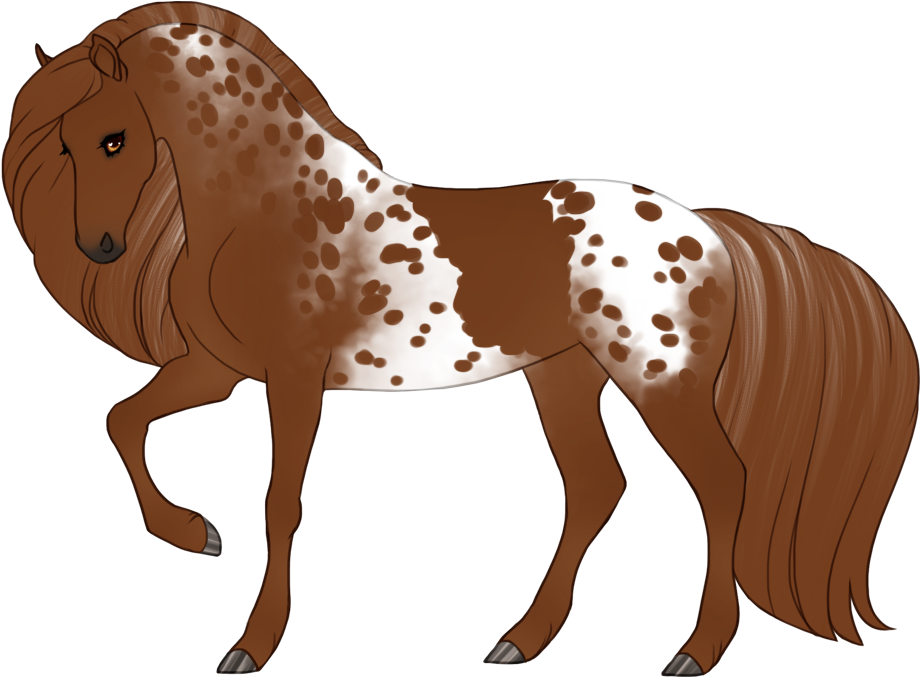
Mismarked semi-leopard appaloosa
chestnut + leopard appaloosa
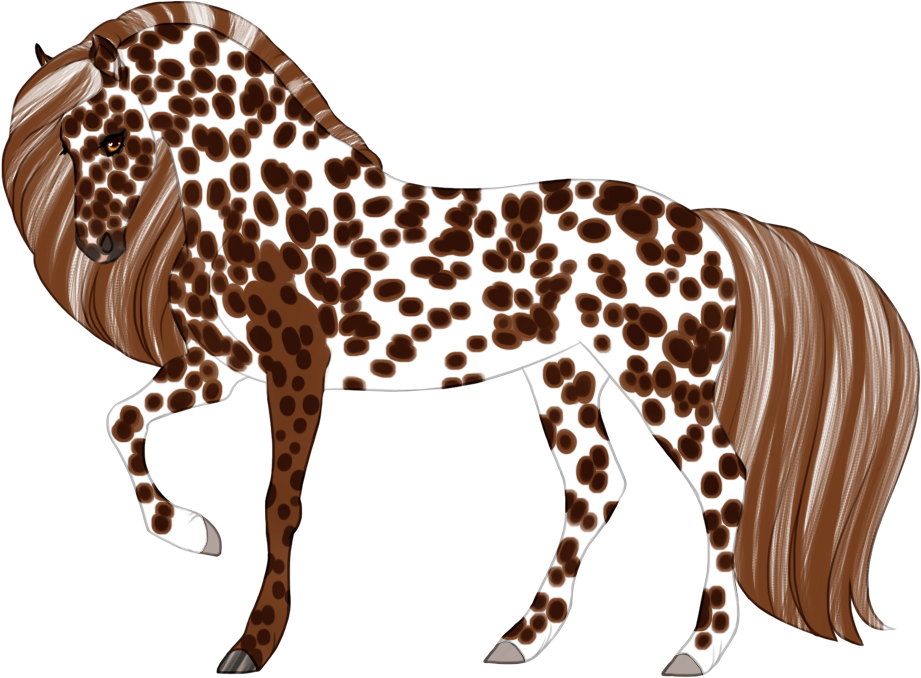
Mismarked leopard appaloosa with dark spots
chestnut + leopard appaloosa
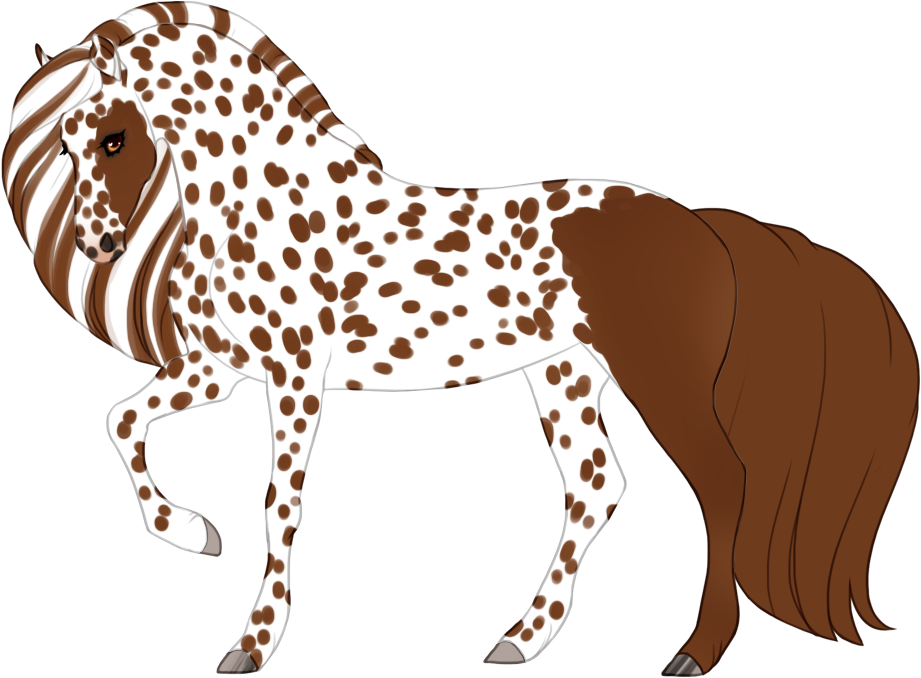
Mismarked leopard appaloosa
chestnut + leopard appaloosa
Optional effect: Peacock
The peacock appaloosa effect causes the spots to have a white halo and speckling around them.
Peacock appaloosa can be combined with other leopard appaloosa patterns, such as blanket leopard appaloosa shown in the example below.
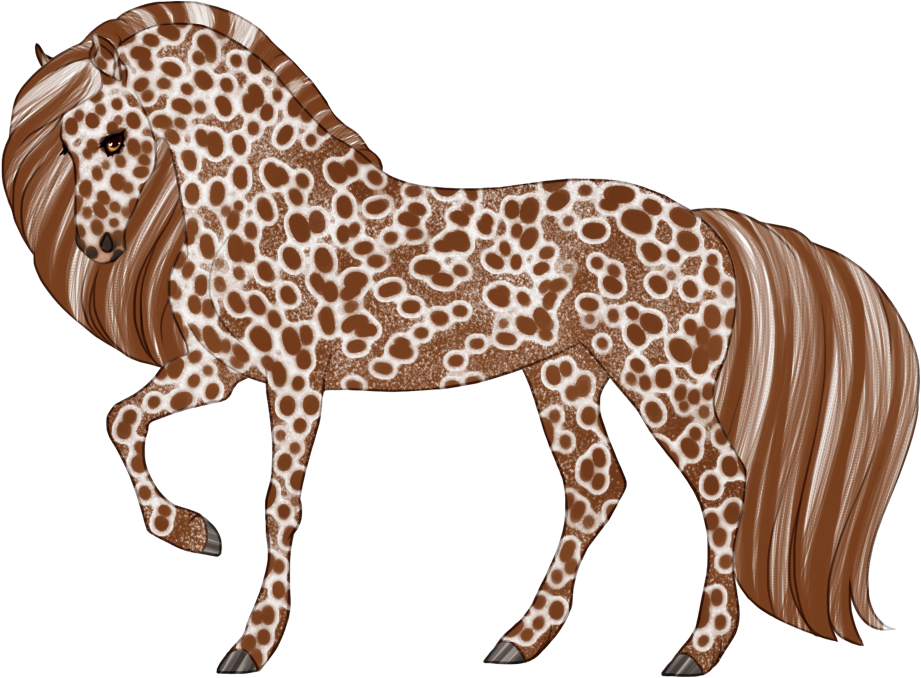
Peacock leopard appaloosa
chestnut + leopard appaloosa
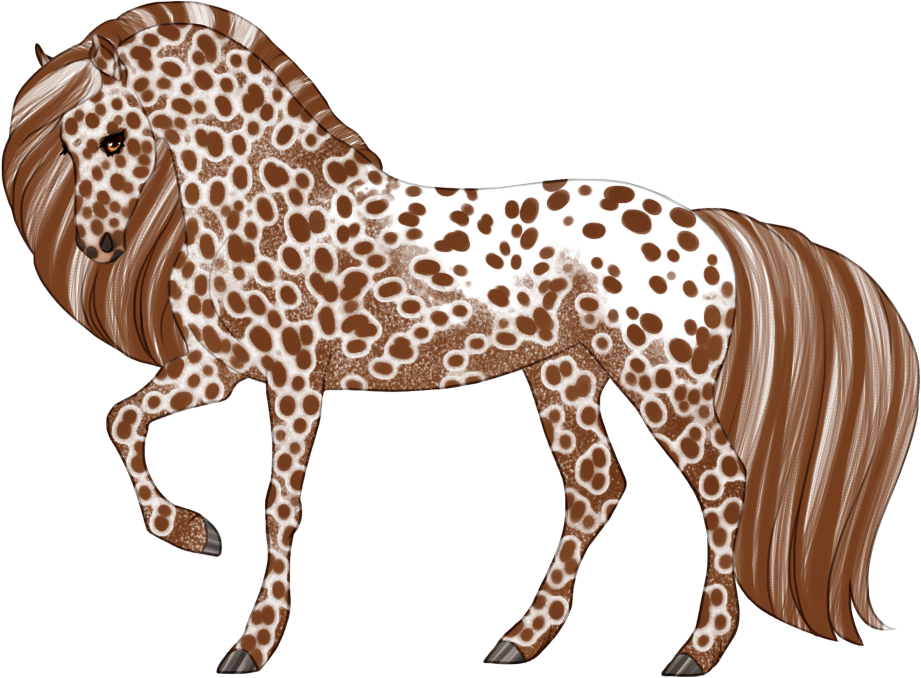
Peacock leopard appaloosa with blanket
chestnut + leopard appaloosa
Effects
- Skin: skin will be light pink under any white patterns, and can optionally be freckled/mottled even if no white spots are near
- Horns and hooves: hooves will be light where white leg markings connect, and can optionally be striped even if no white spots are near [Horn & hoof color guide]
- Eye color: eyes can optionally be blue [Eye color guide]
Appearance
Fewspot appaloosa causes white appaloosa patterns with few or no spots. If any spots are present they should be very small.
Fewspot appaloosa can have very roaned edges on the white markings.
Mane and tail will be affected where white markings touch, however in the case of a snowcap pattern it is optional whether it affects the mane/tail or not.
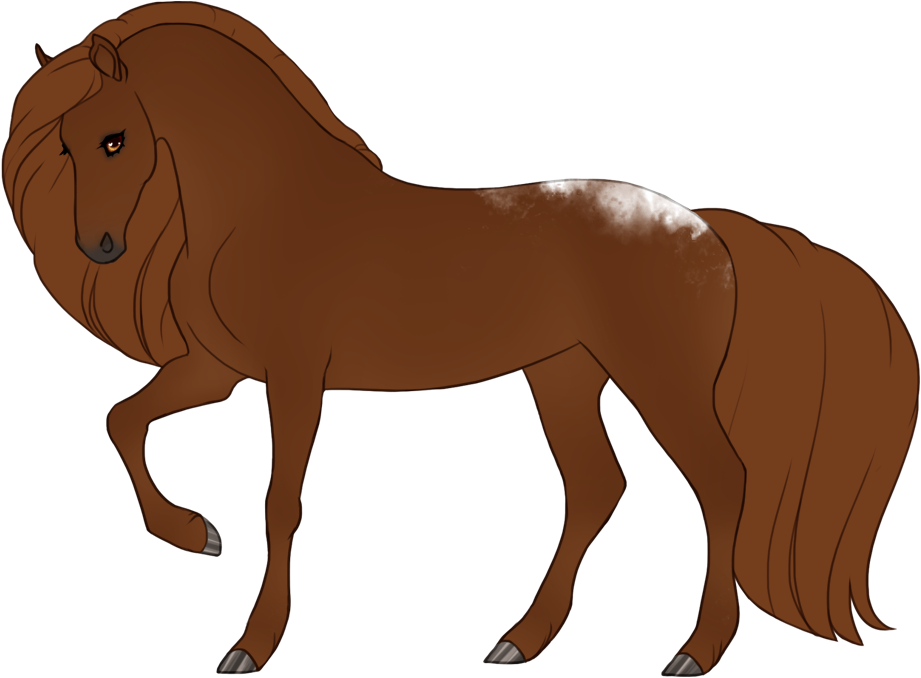
Minimal snowcap fewspot appaloosa
chestnut + fewspot appaloosa
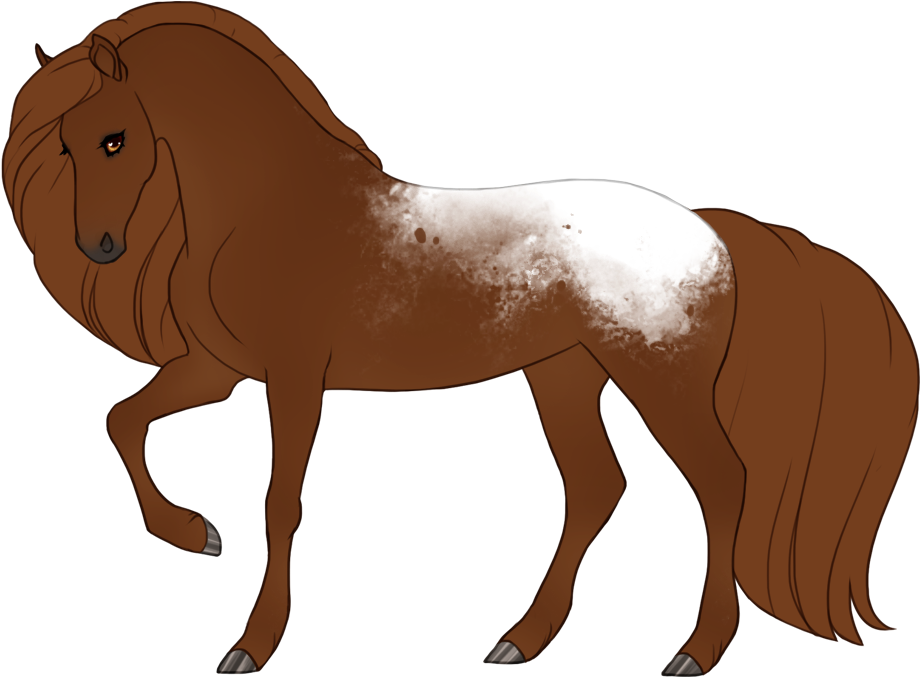
Snowcap fewspot appaloosa
chestnut + fewspot- appaloosa
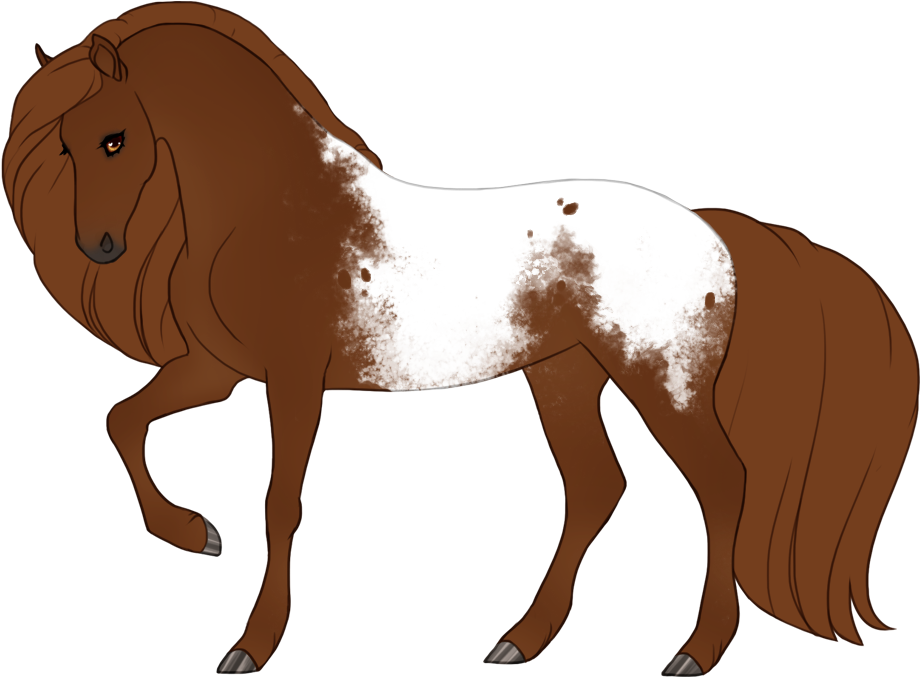
Maximal snowcap fewspot appaloosa
chestnut + fewspot appaloosa
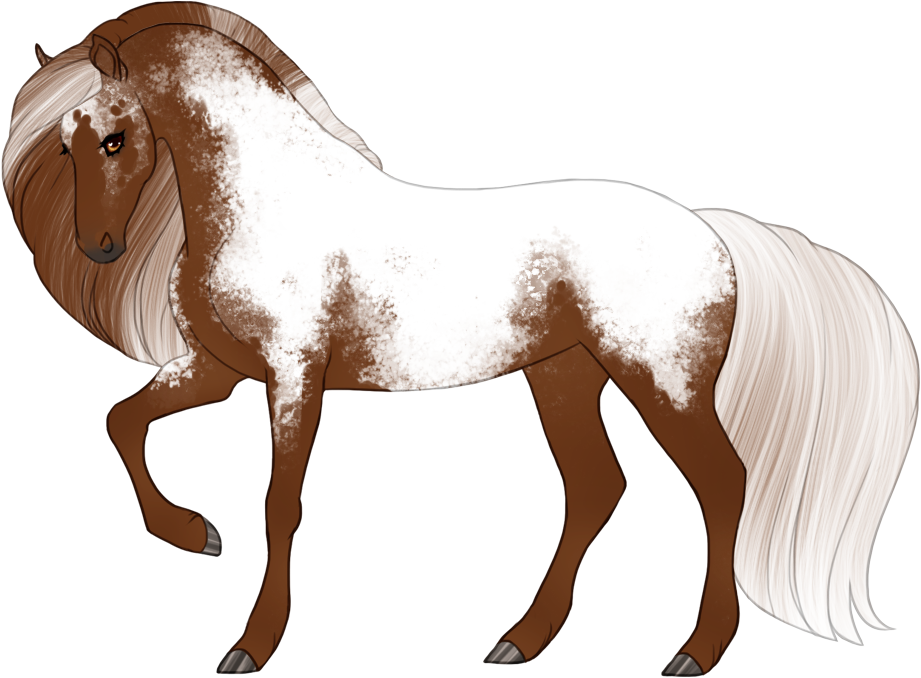
Semi-fewspot appaloosa
chestnut + fewspot appaloosa
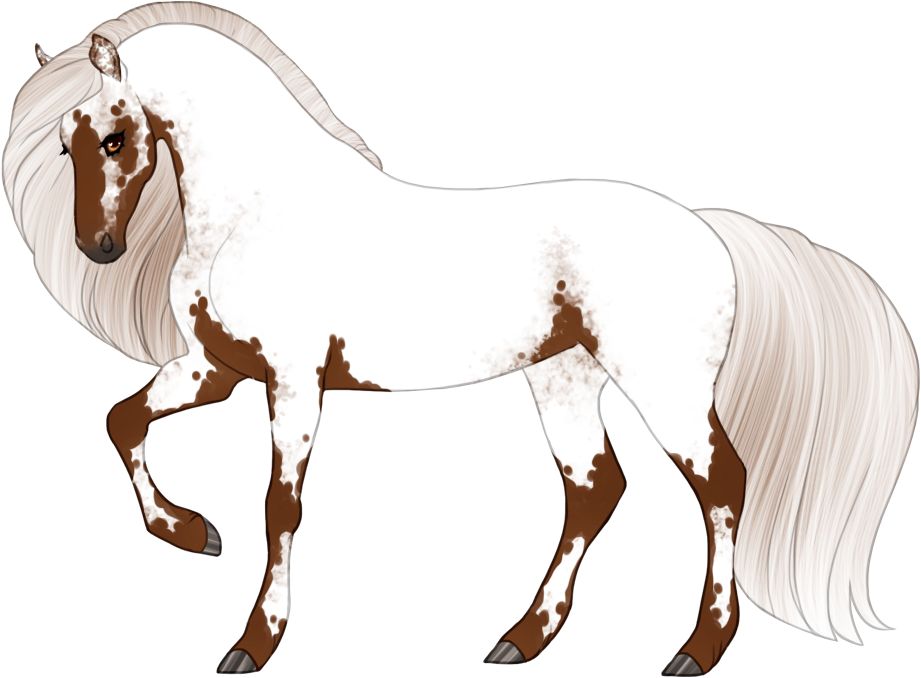
Near-fewspot appaloosa
chestnut + fewspot appaloosa
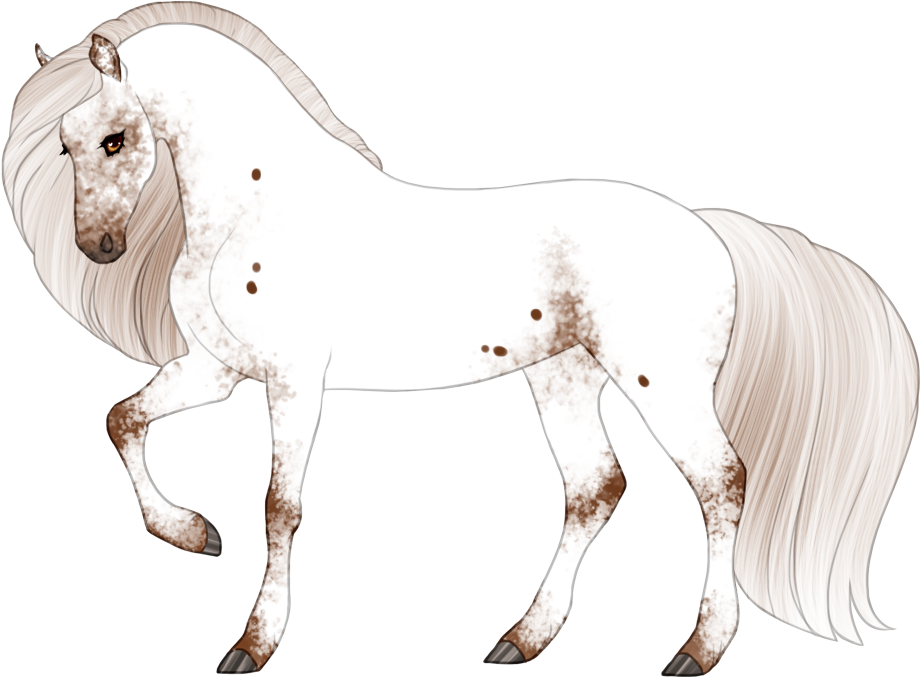
Fewspot appaloosa
chestnut + fewspot appaloosa
Optional effect: Snowflake
Snowflake causes a "reverse leopard" appearance, with white spots on a colored coat.
The white spots should be small, and can have a roaned appearance.
Snowflake appaloosa can be combined with other fewspot appaloosa patterns, such as snowcap fewspot appaloosa.

Snowflake fewspot appaloosa
chestnut + fewspot appaloosa
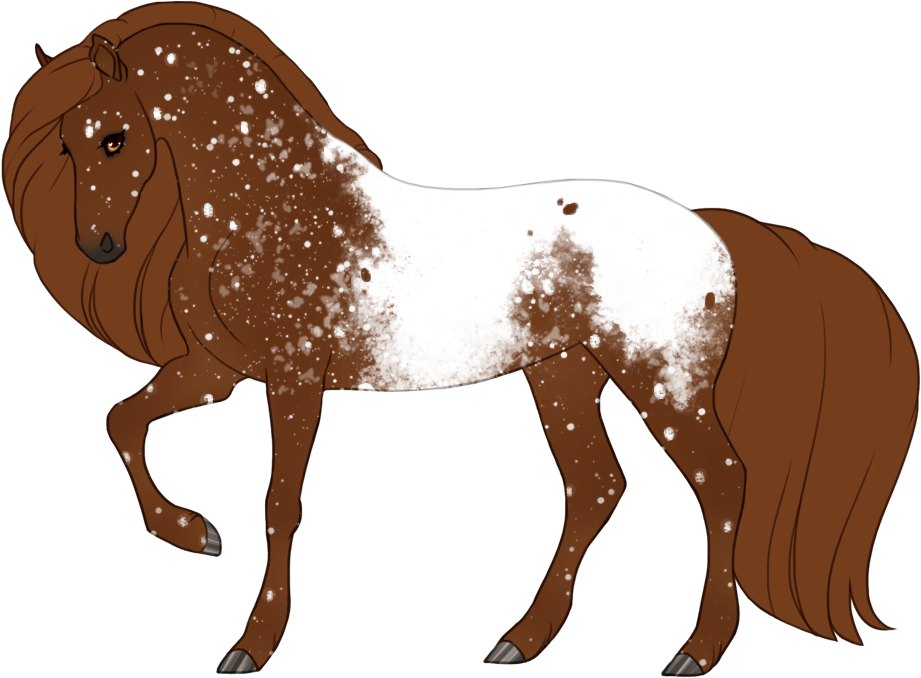
Snowflake blanket fewspot appaloosa
chestnut + fewspot appaloosa
Optional effect: Varnish
Fewspot appaloosa can have a varnished appearance, with a heavily roaned uneven pattern as if the white has been sandpapered off.
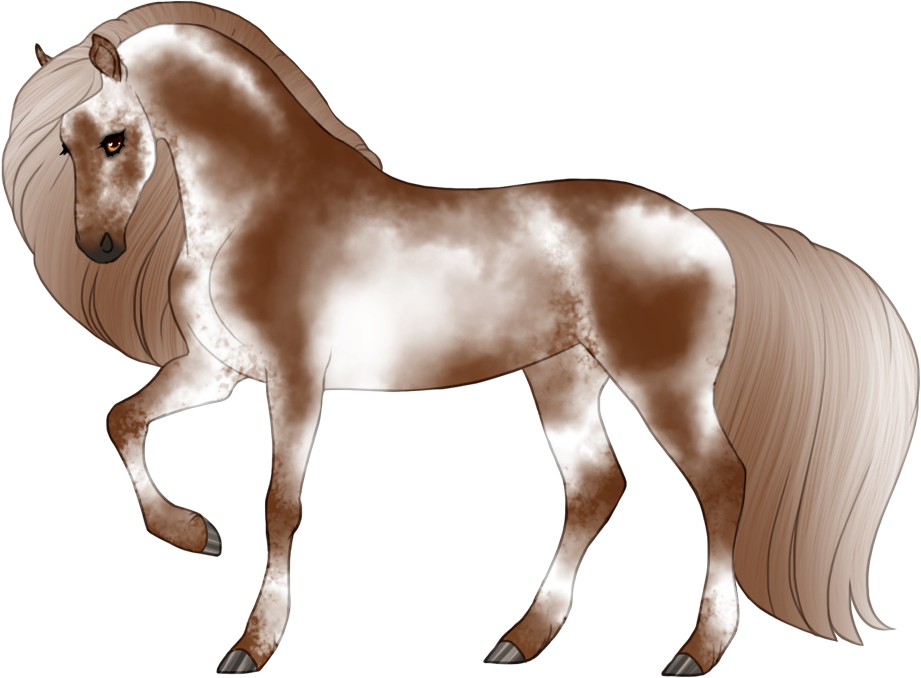
Varnished fewspot appaloosa
chestnut + fewspot appaloosa
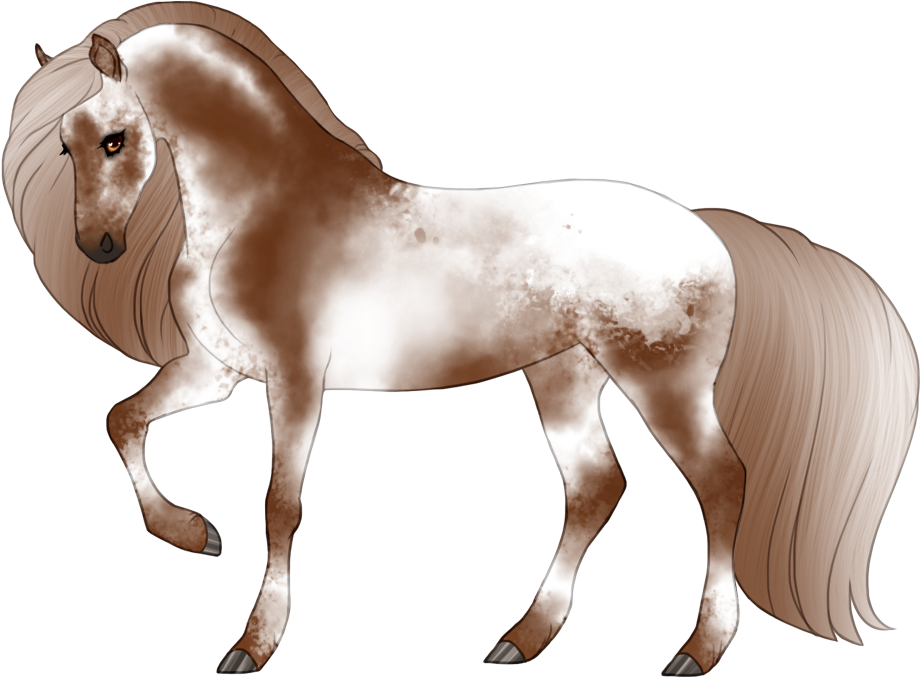
Varnished snowcap fewspot appaloosa
chestnut + fewspot appaloosa

Varnished snowflake fewspot appaloosa
chestnut + fewspot appaloosa
Optional effect: Mismarked
Mismarked appaloosa causes random areas to be absent of white patterns.
Mismarked can appear anywhere on the body and in any size.
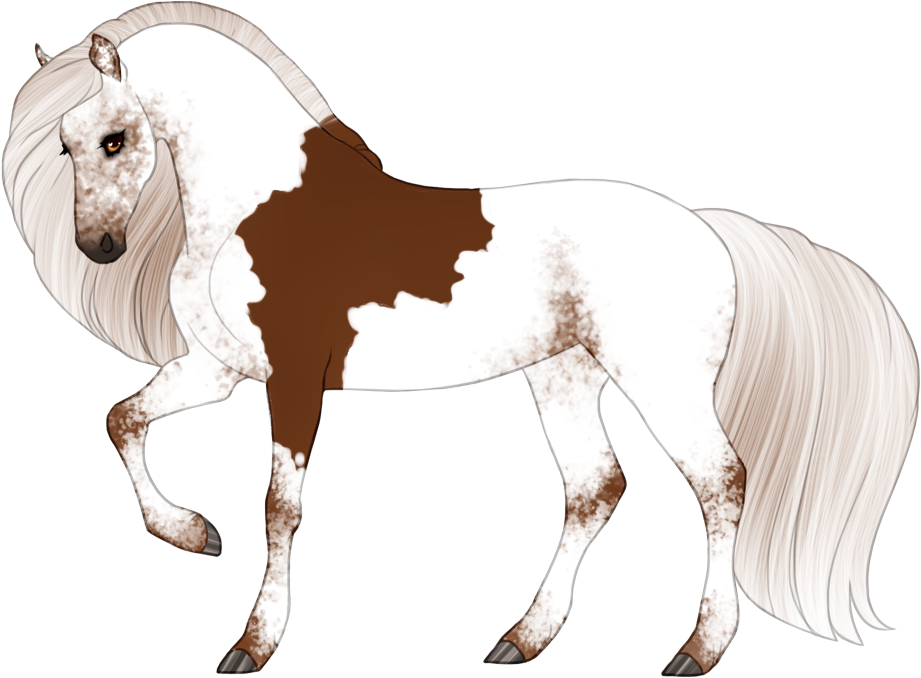
Mismarked fewspot appaloosa
chestnut + fewspot appaloosa
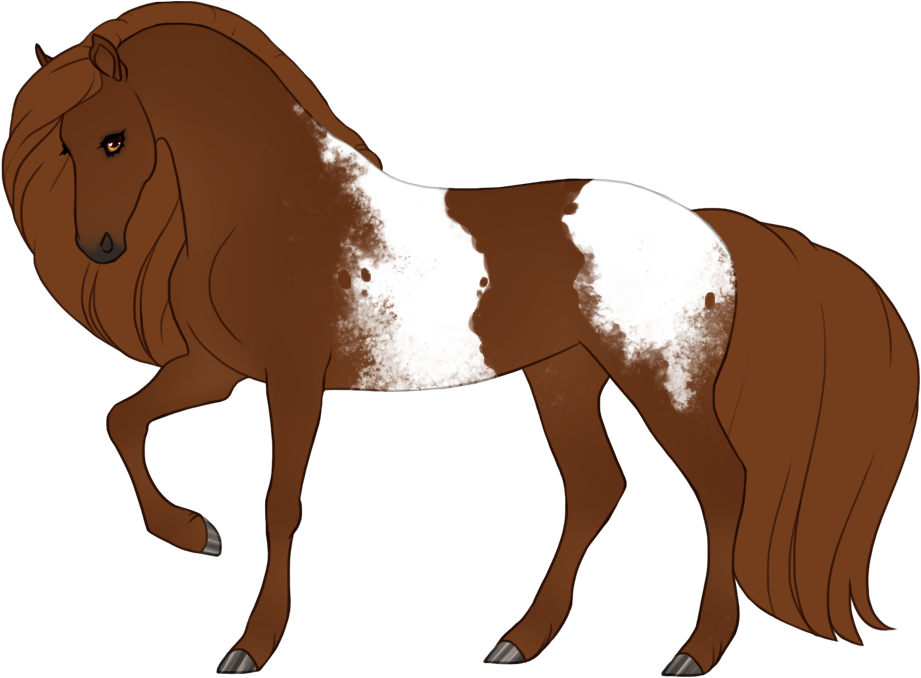
Mismarked snowcap fewspot appaloosa
chestnut + fewspot appaloosa